Structure–Property Correlation and Constitutive Description of Structural Steels during Hot Working and Strain Rate Deformation
Abstract
1. Introduction
Objectives and Organization
- to summarise the state of information on the progress made in understanding the deformation behaviour of plain carbon steels, DP steels, and micro-alloyed steels at different strain rates and during their hot-working conditions along with the experimental methodology and
- to discuss the current research challenges and future research which require attention in this field with a special emphasis on the research gap in the strain-rate behaviour of high carbon steels.
2. Structural Property Correlation
2.1. Low Carbon Steel
2.2. Medium Carbon Steel
2.3. High Carbon Steel
2.4. Dual-Phase (DP) Steel and Micro-Alloyed Steel
3. Numerical Modelling
4. Concluding Remarks
Author Contributions
Funding
Acknowledgments
Conflicts of Interest
References
- Voyiadjis, G.Z.; Palazotto, A.N.; Gao, X.L. Modeling of metallic materials at high strain rates with continuum damage mechanics. Appl. Mech. Rev. 2002, 55, 481–493. [Google Scholar] [CrossRef]
- Johnson, W. Impact Strength of Materials. Johnson, W., Ed.; Edward Arnold: London, UK, 1972. [Google Scholar]
- Clifton, R.J. Response of materials under dynamic loading. Int. J. Solids Struct. 2000, 37, 105–113. [Google Scholar] [CrossRef]
- Sadeghi, H.; Davey, K.; Darvizeh, R.; Darvizeh, A. A scaled framework for strain rate sensitive structures subjected to high rate impact loading. Int. J. Impact Eng. 2019, 125, 229–245. [Google Scholar] [CrossRef]
- Rahmaan, T.; Bardelcik, A.; Imbert, J.; Butcher, C.; Worswick, M.J. Effect of strain rate on flow stress and anisotropy of DP600, TRIP780, and AA5182-O sheet metal alloys. Int. J. Impact Eng. 2016, 88, 72–90. [Google Scholar] [CrossRef]
- Voyiadjis, G.Z.; Faghihi, D. Localization in stainless steel using microstructural based viscoplastic model. Int. J. Impact Eng. 2013, 54, 114–129. [Google Scholar] [CrossRef]
- Xue, P.; Iqbal, N.; Liao, H.J.; Wang, B.; Li, Y.L. Experimental study, on strain rate sensitivity of ductile porous irons. Int. J. Impact Eng. 2012, 48, 82–86. [Google Scholar] [CrossRef]
- Bruschi, S.; Altan, T.; Banabic, D.; Bariani, P.F.; Brosius, A.; Cao, J.; Ghiotti, A.; Khraisheh, M.; Merklein, M.; Tekkaya, A.E. Testing and modelling of material behaviour and formability in sheet metal forming. CIRP Ann. Manuf. Technol. 2014, 63, 727–749. [Google Scholar] [CrossRef]
- Piao, M.; Huh, H.; Lee, I.; Ahn, K.; Kim, H.; Park, L. Characterization of flow stress at ultra-high strain rates by proper extrapolation with Taylor impact tests. Int. J. Impact Eng. 2016, 91, 142–157. [Google Scholar] [CrossRef]
- Mirmomeni, M.; Heidarpour, A.; Zhao, X.-L.; Hutchinson, C.R.; Packer, J.A.; Wu, C. Fracture behaviour and microstructural evolution of structural mild steel under the multi-hazard loading of high-strain-rate load followed by elevated temperature. Constr. Build. Mater. 2016, 122, 760–771. [Google Scholar] [CrossRef]
- Mirmomeni, M.; Heidarpour, A.; Zhao, X.-L.; Hutchinson, C.R.; Packer, J.A.; Wu, C. Mechanical properties of partially damaged structural steel induced by high strain rate loading at elevated temperatures – An experimental investigation. Int. J. Impact Eng. 2015, 76, 178–188. [Google Scholar] [CrossRef]
- Javidan, F.; Heidarpour, A.; Zhao, X.L.; Minkkinen, J. Performance of innovative fabricated long hollow columns under axial compression. J. Constr. Steel Res. 2015, 106, 99–109. [Google Scholar] [CrossRef]
- He, Z.; He, Y.; Ling, Y.; Wu, Q.; Gao, Y.; Li, L. Effect of strain rate on deformation behavior of TRIP steels. J. Mater. Process. Technol. 2012, 212, 2141–2147. [Google Scholar] [CrossRef]
- Nemat-Nasser, S. Introduction to High Strain Rate Testing. ASM Handb. 2000, 8, 427–428. [Google Scholar]
- Woodward, R. Material failure at high strain rates. In High Velocity Impact Dynamics; John Wiley & Sons: NewYork, NY, USA, 1990; pp. 65–125. [Google Scholar]
- Sierakowski, R.L. Strain Rate Effects in Composites. Appl. Mech. Rev. 1997, 50, 741–761. [Google Scholar] [CrossRef]
- Gray, G.T., III. High-Strain-Rate Deformation: Mechanical Behavior and Deformation Substructures Induced. Annu. Rev. Mater. Res. 2012, 42, 285–303. [Google Scholar] [CrossRef]
- Meyers, M.A.; Benson, D.J.; Vöhringer, O.; Kad, B.K.; Xue, Q.; Fu, H.H. Constitutive description of dynamic deformation: Physically-based mechanisms. Mater. Sci. Eng. A 2002, 322, 194–216. [Google Scholar] [CrossRef]
- Lennon, A.M.; Ramesh, K.T. The influence of crystal structure on the dynamic behavior of materials at high temperatures. Int. J. Plast. 2004, 20, 269–290. [Google Scholar] [CrossRef]
- Kruml, T.; Coddet, O.; Martin, J.L. About the determination of the thermal and athermal stress components from stress-relaxation experiments. Acta Mater. 2008, 56, 333–340. [Google Scholar] [CrossRef]
- Conrad, H. The athermal component of the flow stress in crystalline solids. Mater. Sci. Eng. 1970, 6, 265–273. [Google Scholar] [CrossRef]
- Paul, S.K.; Raj, A.; Biswas, P.; Manikandan, G.; Verma, R.K. Tensile flow behavior of ultra low carbon, low carbon and micro alloyed steel sheets for auto application under low to intermediate strain rate. Mater. Des. 2014, 57, 211–217. [Google Scholar] [CrossRef]
- Lee, W.-S.; Lin, C.-F. Comparative study of the impact response and microstructure of 304L stainless steel with and without prestrain. Metall. Mater. Trans. A 2002, 33, 2801–2810. [Google Scholar] [CrossRef]
- Yoshizawa, M.; Ohsawa, H. Evaluation of strain-rate sensitivity in superplastic compressive deformation. J. Mater. Process. Technol. 1997, 68, 206–214. [Google Scholar] [CrossRef]
- Wang, L.L.; Li, R.B.; Liao, Y.G.; Jin, M. Study on characterization of hot deformation of 403 steel. Mater. Sci. Eng. A 2013, 567, 84–88. [Google Scholar] [CrossRef]
- Fang, Y.L.; Liu, Z.Y.; Song, H.M.; Jiang, L.Z. Hot deformation behavior of a new austenite–ferrite duplex stainless steel containing high content of nitrogen. Mater. Sci. Eng. A 2009, 526, 128–133. [Google Scholar] [CrossRef]
- Momeni, A.; Dehghani, K. Effect of Hot Working on Secondary Phase Formation in 2205 Duplex Stainless Steel. J. Mater. Sci. Technol. 2010, 26, 851–857. [Google Scholar] [CrossRef]
- Chen, L.; Ma, X.; Liu, X.; Wang, L. Processing map for hot working characteristics of a wrought 2205 duplex stainless steel. Mater. Des. 2011, 32, 1292–1297. [Google Scholar] [CrossRef]
- Puchi-Cabrera, E.S.; Staia, M.H.; Guérin, J.D.; Lesage, J.; Dubar, M.; Chicot, D. Analysis of the work-hardening behavior of C–Mn steels deformed under hot-working conditions. Int. J. Plast. 2013, 51, 145–160. [Google Scholar] [CrossRef]
- Zhao, B.; Zhao, T.; Li, G.; Lu, Q. The kinetics of dynamic recrystallization of a low carbon vanadium-nitride microalloyed steel. Mater. Sci. Eng. A 2014, 604, 117–121. [Google Scholar] [CrossRef]
- Shi, C.-J.; Chen, X.-G. Hot Deformation Behavior and Microstructural Evolution of Homogenized 7150 Aluminum Alloys Micro-Alloyed with Zr and V. In ICAA13 Pittsburgh; Weiland, H., Rollett, A.D., Cassada, W.A., Eds.; Springer International Publishing: Cham, Switzerland, 2016; pp. 1599–1605. [Google Scholar]
- Li, A.B.; Huang, L.J.; Meng, Q.Y.; Geng, L.; Cui, X.P. Hot working of Ti-6Al-3Mo-2Zr-0.3Si alloy with lamellar α + β starting structure using processing map. Mater. Des. 2009, 30, 1625–1631. [Google Scholar] [CrossRef]
- Chun, X.; Sun, Q.; Chen, X. Research on transformation mechanism and microstructure evolution rule of vanadium-nitrogen microalloyed steels. Mater. Des. 2007, 28, 2523–2527. [Google Scholar] [CrossRef]
- Mirzadeh, H.; Najafizadeh, A. The rate of dynamic recrystallization in 17-4 PH stainless steel. Mater. Des. 2010, 31, 4577–4583. [Google Scholar] [CrossRef]
- Momeni, A.; Abbasi, S.M.; Badri, H. Hot deformation behavior and constitutive modeling of VCN200 low alloy steel. Appl. Math. Model. 2012, 36, 5624–5632. [Google Scholar] [CrossRef]
- Momeni, A.; Arabi, H.; Rezaei, A.; Badri, H.; Abbasi, S.M. Hot deformation behavior of austenite in HSLA-100 microalloyed steel. Mater. Sci. Eng. A 2011, 528, 2158–2163. [Google Scholar] [CrossRef]
- Bianchi, J.H.; Karjalainen, L.P. Modelling of dynamic and metadynamic recrystallisation during bar rolling of a medium carbon spring steel. J. Mater. Process. Technol. 2005, 160, 267–277. [Google Scholar] [CrossRef]
- Yang, Z.; Zhang, F.; Zheng, C.; Zhang, M.; Lv, B.; Qu, L. Study on hot deformation behaviour and processing maps of low carbon bainitic steel. Mater. Des. 2015, 66, 258–266. [Google Scholar] [CrossRef]
- Visser, W.; Ghonem, H. Twin nucleation in cold rolled low carbon steel subjected to plate impacts. Mater. Sci. Eng. A 2017, 687, 28–38. [Google Scholar] [CrossRef]
- Qin, J.; Chen, R.; Wen, X.; Lin, Y.; Liang, M.; Lu, F. Mechanical behaviour of dual-phase high-strength steel under high strain rate tensile loading. Mater. Sci. Eng. A 2013, 586, 62–70. [Google Scholar] [CrossRef]
- Kuziak, R.; Kawalla, R.; Waengler, S. Advanced high strength steels for automotive industry. Arch. Civ. Mech. Eng. 2008, 8, 103–117. [Google Scholar] [CrossRef]
- De Cooman, B.C. Structure–properties relationship in TRIP steels containing carbide-free bainite. Curr. Opin. Solid State Mater. Sci. 2004, 8, 285–303. [Google Scholar] [CrossRef]
- Kumar, A.S.; Kumar, B.R.; Datta, G.L.; Ranganath, V.R. Effect of microstructure and grain size on the fracture toughness of a micro-alloyed steel. Mater. Sci. Eng. A 2010, 527, 954–960. [Google Scholar] [CrossRef]
- Tiamiyu, A.A.; Eskandari, M.; Nezakat, M.; Wang, X.; Szpunar, J.A.; Odeshi, A.G. A comparative study of the compressive behaviour of AISI 321 austenitic stainless steel under quasi-static and dynamic shock loading. Mater. Des. 2016, 112, 309–319. [Google Scholar] [CrossRef]
- Verleysen, P.; Peirs, J.; Van Slycken, J.; Faes, K.; Duchene, L. Effect of strain rate on the forming behaviour of sheet metals. J. Mater. Process. Technol. 2011, 211, 1457–1464. [Google Scholar] [CrossRef]
- Davis, J.R. (Ed.) High-Strength-Low-Alloy Steels; ASM International: Materials Park, OH, USA, 2001. [Google Scholar]
- Matlock, D.K.; Speer, J.G. Third Generation of AHSS: Microstructure Design Concepts. In Microstructure and Texture in Steels: And Other Materials; Haldar, A., Suwas, S., Bhattacharjee, D., Eds.; Springer London: London, UK, 2009; pp. 185–205. [Google Scholar]
- Carbon Steel Handbook 1014670; EPRI: Palo Alto, CA, USA, 2007.
- Hossain, R.; Pahlevani, F.; Quadir, M.Z.; Sahajwalla, V. Stability of retained austenite in high carbon steel under compressive stress: An investigation from macro to nano scale. Sci. Rep. 2016, 6, 34958. [Google Scholar] [CrossRef] [PubMed]
- Lesuer, D.R.; Syn, C.K.; Goldberg, A.; Wadsworth, J.; Sherby, O.D. The case for ultrahigh-carbon steels as structural materials. JOM 1993, 45, 40–46. [Google Scholar] [CrossRef]
- Farabi, N.; Chen, D.L.; Zhou, Y. Microstructure and mechanical properties of laser welded dissimilar DP600/DP980 dual-phase steel joints. J. Alloy. Compd. 2011, 509, 982–989. [Google Scholar] [CrossRef]
- Maris, C.; Hassannejadasl, A.; Green, D.E.; Cheng, J.; Golovashchenko, S.F.; Gillard, A.J.; Liang, Y. Comparison of quasi-static and electrohydraulic free forming limits for DP600 and AA5182 sheets. J. Mater. Process. Technol. 2016, 235, 206–219. [Google Scholar] [CrossRef]
- Samei, J.; Green, D.E.; Cheng, J.; de Carvalho Lima, M.S. Influence of strain path on nucleation and growth of voids in dual phase steel sheets. Mater. Des. 2016, 92, 1028–1037. [Google Scholar] [CrossRef]
- Topçu, O.; Übeyli, M. On the microstructural and mechanical characterizations of a low carbon and micro-alloyed steel. Mater. Des. 2009, 30, 3274–3278. [Google Scholar] [CrossRef]
- Tavares, S.S.M.; Pedroza, P.D.; Teodósio, J.R.; Gurova, T. Mechanical properties of a quenched and tempered dual phase steel. Scr. Mater. 1999, 40, 887–892. [Google Scholar] [CrossRef]
- Mohanty, O.N. Forging Grade Steels for Automotives. In Automotive Steels; Woodhead Publishing: Cambridge, UK, 2017; pp. 413–453. [Google Scholar]
- McCune, R.C.; Weber, G.A. Automotive Engine Materials A2 - Buschow, K.H. Jürgen. In Encyclopedia of Materials: Science and Technology, 2nd ed.; Cahn, R.W., Flemings, M.C., Ilschner, B., Kramer, E.J., Mahajan, S., Veyssière, P., Eds.; Elsevier: Oxford, UK, 2001; pp. 426–434. [Google Scholar]
- Tsuchida, N.; Nakano, H.; Okamoto, T.; Inoue, T. Effect of strain rate on true stress–true strain relationships of ultrafine-grained ferrite–cementite steels up to plastic deformation limit. Mater. Sci. Eng. A 2015, 626, 441–448. [Google Scholar] [CrossRef]
- Korkolis, Y.P.; Mitchell, B.R.; Locke, M.R.; Kinsey, B.L. Plastic flow and anisotropy of a low-carbon steel over a range of strain-rates. Int. J. Impact Eng. 2018, 121, 157–171. [Google Scholar] [CrossRef]
- Zeng, X.; Huo, J.; Wang, H.; Wang, Z.; Elchalakani, M. Dynamic Tensile Behavior of Steel HRB500E Reinforcing Bar at Low, Medium, and High Strain Rates. Materials 2020, 13, 185. [Google Scholar] [CrossRef] [PubMed]
- Lin, F.; Dong, Y.; Kuang, X.; Lu, L. Strain Rate Behavior in Tension of Reinforcing Steels HPB235, HRB335, HRB400, and HRB500. Materials 2016, 9, 1013. [Google Scholar] [CrossRef] [PubMed]
- Campbell, J.D.; Ferguson, W.G. The temperature and strain-rate dependence of the shear strength of mild steel. Philos. Mag. 1970, 21, 63–82. [Google Scholar] [CrossRef]
- Klepaczko, J.R. An experimental technique for shear testing at high and very high strain rates. The case of a mild steel. Int. J. Impact Eng. 1994, 15, 25–39. [Google Scholar] [CrossRef]
- Hurley, P.J.; Hodgson, P.D. Formation of ultra-fine ferrite in hot rolled strip: Potential mechanism for grain refinement. Mater. Sci. Eng. A 2001, 302, 206–214. [Google Scholar] [CrossRef]
- Yada, H.; Li, C.M.; Yamagata, H. Dynamic γ→α transformation during hot deformation in iron-nickel-carbon alloys. ISIJ Int. 2000, 40, 200–206. [Google Scholar] [CrossRef]
- Ok, S.Y.; Park, J.K. Dynamic austenite-to-ferrite transformation behavior of plain low carbon steel within (γ + α) 2-phase field at low strain rate. Scr. Mater. 2005, 52, 1111–1116. [Google Scholar] [CrossRef]
- Chung, J.H.; Park, J.K.; Kim, T.H.; Kim, K.H.; Ok, S.Y. Study of deformation-induced phase transformation in plain low carbon steel at low strain rate. Mater. Sci. Eng. A 2010, 527, 5072–5077. [Google Scholar] [CrossRef]
- Rizhi, W.; Lei, T.C. Substructural evolution of ferrite in a low carbon steel during hot deformation in (F+A) two-phase range. Scr. Metall. Et Mater. 1993, 28, 629–632. [Google Scholar] [CrossRef]
- Shakerifard, B.; Lopez, J.G.; Legaza, M.C.T.; Verleysen, P.; Kestens, L.A. Strain rate dependent dynamic mechanical response of bainitic multiphase steels. Mater. Sci. Eng. A 2019, 745, 279–290. [Google Scholar] [CrossRef]
- Tiamiyu, A.A.; Odeshi, A.G.; Szpunar, J.A. Multiple strengthening sources and adiabatic shear banding during high strain-rate deformation of AISI 321 austenitic stainless steel: Effects of grain size and strain rate. Mater. Sci. Eng. A 2018, 711, 233–249. [Google Scholar] [CrossRef]
- Bloniarz, R.; Majta, J.; Trujillo, C.; Cerreta, E.; Muszka, K. The mechanisms for strengthening under dynamic loading for low carbon and microalloyed steel. Int. J. Impact Eng. 2018, 114, 53–62. [Google Scholar] [CrossRef]
- Jiang, M.; Devincre, B.; Monnet, G. Effects of the grain size and shape on the flow stress: A dislocation dynamics study. Int. J. Plast. 2019, 113, 111–124. [Google Scholar] [CrossRef]
- Ohmori, A.; Torizuka, S.; Nagai, K.; Koseki, N.; Kogo, Y. Effect of deformation temperature and strain rate on evolution of ultrafine grained structure through single-pass large-strain warm deformation in a low carbon steel. Mater. Trans. 2004, 45, 2224–2231. [Google Scholar] [CrossRef]
- Medina, S.F.; Hernandez, C.A. General expression of the Zener-Hollomon parameter as a function of the chemical composition of low alloy and microalloyed steels. Acta Mater. 1996, 44, 137–148. [Google Scholar] [CrossRef]
- Razmpoosh, M.H.; Zarei-Hanzaki, A.; Imandoust, A. Effect of the Zener–Hollomon parameter on the microstructure evolution of dual phase TWIP steel subjected to friction stir processing. Mater. Sci. Eng. A 2015, 638, 15–19. [Google Scholar] [CrossRef]
- Li, Y.S.; Zhang, Y.; Tao, N.R.; Lu, K. Effect of the Zener–Hollomon parameter on the microstructures and mechanical properties of Cu subjected to plastic deformation. Acta Mater. 2009, 57, 761–772. [Google Scholar] [CrossRef]
- Narayana Murty, S.V.S.; Torizuka, S.; Nagai, K.; Kitai, T.; Kogo, Y. Grain boundary diffusion controlled ultrafine grain formation during large strain-high Z deformation of coarse (200 μm) grained ultra-low carbon steel. Mater. Sci. Eng. A 2007, 457, 162–168. [Google Scholar] [CrossRef]
- Murty, S.V.S.N.; Torizuka, S.; Nagai, K.; Kitai, T.; Kogo, Y. Dynamic recrystallization of ferrite during warm deformation of ultrafine grained ultra-low carbon steel. Scr. Mater. 2005, 53, 763–768. [Google Scholar] [CrossRef]
- Kang, J.-H.; Torizuka, S. Dynamic recrystallization by large strain deformation with a high strain rate in an ultralow carbon steel. Scr. Mater. 2007, 57, 1048–1051. [Google Scholar] [CrossRef]
- Rajput, S.K.; Chaudhari, G.P.; Nath, S.K. Characterization of hot deformation behavior of a low carbon steel using processing maps, constitutive equations and Zener-Hollomon parameter. J. Mater. Process. Technol. 2016, 237, 113–125. [Google Scholar] [CrossRef]
- Johnson, P.E.; Schmitt, J.H.; Vincent, S.A.; Morris, J.W. The effect of prestrain temperatures on dislocation cell formation and subsequent tensile behavior in low carbon steel sheets. Scr. Metall. Et Mater. 1990, 24, 1447–1452. [Google Scholar] [CrossRef]
- Rajput, S.K.; Dikovits, M.; Chaudhari, G.P.; Poletti, C.; Warchomicka, F.; Pancholi, V.; Nath, S.K. Physical simulation of hot deformation and microstructural evolution of AISI 1016 steel using processing maps. Mater. Sci. Eng. A 2013, 587, 291–300. [Google Scholar] [CrossRef]
- Huang, Y.D.; Froyen, L. Important factors to obtain homogeneous and ultrafine ferrite-pearlite microstructure in low carbon steel. J. Mater. Process. Technol. 2002, 124, 216–226. [Google Scholar] [CrossRef]
- Du, L.-X.; Zhang, Z.-P.; She, G.-F.; Liu, X.-H.; Wang, G.-D. Austenite Recrystallization and Controlled Rolling of Low Carbon Steels. J. Iron Steel Res. Int. 2006, 13, 31–50. [Google Scholar] [CrossRef]
- McCormick, P.G. Strain rate sensitivity prior to the onset of serrated yielding in a pressurized low carbon steel. Scr. Metall. 1978, 12, 197–200. [Google Scholar] [CrossRef]
- Rao, K.P.; Prasad, Y.K.D.V.; Hawbolt, E.B. Hot deformation studies on a low-carbon steel: Part 1 - Flow curves and the constitutive relationship. J. Mater. Process. Technol. 1996, 56, 897–907. [Google Scholar] [CrossRef]
- Eghbali, B.; Shaban, M. Warm Deformation Microstructure of a Plain Carbon Steel. J. Iron Steel Res. Int. 2011, 18, 41–46. [Google Scholar] [CrossRef]
- Bayramin, B.; Şimşir, C.; Efe, M. Dynamic strain aging in DP steels at forming relevant strain rates and temperatures. Mater. Sci. Eng. A 2017, 704, 164–172. [Google Scholar] [CrossRef]
- Cai, H.; Song, R.; Jiang, L.; Wei, R.; Li, Y.; Niu, W. Plastic deformation behavior and construction of constitutive model in a wide range of strain rates of 800MPa grade dual phase steel. Mech. Mater. 2018, 122, 104–117. [Google Scholar] [CrossRef]
- Huh, H.; Yoon, J.-H.; Park, C.-G.; Kang, J.-S.; Huh, M.-Y.; Kang, H.-G. Correlation of microscopic structures to the strain rate hardening of SPCC steel. Int. J. Mech. Sci. 2010, 52, 745–753. [Google Scholar] [CrossRef]
- Hwang, S.W.; Ji, J.H.; Park, K.-T. Effects of Al addition on high strain rate deformation of fully austenitic high Mn steels. Mater. Sci. Eng. A 2011, 528, 7267–7275. [Google Scholar] [CrossRef]
- Qin, F.; Zhu, H.; Wang, Z.; Zhao, X.; He, W.; Chen, H. Dislocation and twinning mechanisms for dynamic recrystallization of as-cast Mn18Cr18N steel. Mater. Sci. Eng. A 2017, 684, 634–644. [Google Scholar] [CrossRef]
- Monteiro, S.N.; Nascimento, L.F.C.; Simonassi, N.T.; Lima, E.S.; Paula, A.S.D.; Braga, F.D.O. High temperature work hardening stages, dynamic strain aging and related dislocation structure in tensile deformed AISI 301 stainless steel. J. Mater. Res. Technol. 2018, 7, 571–577. [Google Scholar] [CrossRef]
- Ghazani, M.S.; Eghbali, B. Characterization of the hot deformation microstructure of AISI 321 austenitic stainless steel. Mater. Sci. Eng. A 2018, 730, 380–390. [Google Scholar] [CrossRef]
- Gao, X.J.; Jiang, Z.Y.; Wei, D.B.; Li, H.J.; Jiao, S.H.; Xu, J.; Zhang, X.M.; Han, J.T.; Chen, D.F. Constitutive analysis for hot deformation behaviour of novel bimetal consisting of pearlitic steel and low carbon steel. Mater. Sci. Eng. A 2014, 595, 1–9. [Google Scholar] [CrossRef]
- Xie, Z.-X.; Gao, H.-Y.; Wang, J.; Yu, Y.; Fang, Y.; Sun, B.-D. Static Recrystallization Behavior of Twin Roll Cast Low-Carbon Steel Strip. J. Iron Steel Res. Int. 2011, 18, 45–51. [Google Scholar] [CrossRef]
- Wang, J.; Xiao, H.; Xie, H.; Xu, X.; Gao, Y. Study on hot deformation behavior of carbon structural steel with flow stress. Mater. Sci. Eng. A 2012, 539, 294–300. [Google Scholar] [CrossRef]
- Li, X.; Li, J.; Ding, W.; Zhao, S.; Chen, J. Stress Relaxation in Tensile Deformation of 304 Stainless Steel. J. Mater. Eng. Perform. 2017, 26, 630–635. [Google Scholar] [CrossRef]
- Hariharan, K.; Majidi, O.; Kim, C.; Lee, M.G.; Barlat, F. Stress relaxation and its effect on tensile deformation of steels. Mater. Des. 2013, 52, 284–288. [Google Scholar] [CrossRef]
- Tsuchida, N.; Masuda, H.; Harada, Y.; Fukaura, K.; Tomota, Y.; Nagai, K. Effect of ferrite grain size on tensile deformation behavior of a ferrite-cementite low carbon steel. Mater. Sci. Eng. A 2008, 488, 446–452. [Google Scholar] [CrossRef]
- Sun, H.B.; Yoshida, F.; Ohmori, M.; Ma, X. Effect of strain rate on Lüders band propagating velocity and Lüders strain for annealed mild steel under uniaxial tension. Mater. Lett. 2003, 57, 4535–4539. [Google Scholar] [CrossRef]
- Xu, Y.B.; Bai, Y.L.; Xue, Q.; Shen, L.T. Formation, microstructure and development of the localized shear deformation in low-carbon steels. Acta Mater. 1996, 44, 1917–1926. [Google Scholar] [CrossRef]
- Saadatkia, S.; Mirzadeh, H.; Cabrera, J.-M. Hot deformation behavior, dynamic recrystallization, and physically-based constitutive modeling of plain carbon steels. Mater. Sci. Eng. A 2015, 636, 196–202. [Google Scholar] [CrossRef]
- Li, H.-B.; Feng, Y.-L.; Yan, T.; Yu, E.-L. Constitutive Model of Warm Deformation Behavior of Medium Carbon Steel. J. Iron Steel Res. Int. 2016, 23, 940–948. [Google Scholar] [CrossRef]
- Chai, R.-X.; Guo, C.; Yu, L. Two flowing stress models for hot deformation of XC45 steel at high temperature. Mater. Sci. Eng. A 2012, 534, 101–110. [Google Scholar] [CrossRef]
- Zhao, X.; Yang, X.-L.; Jing, T.-F. Effect of Initial Microstructure on Warm Deformation Behavior of 45 Steel. J. Iron Steel Res. Int. 2012, 19, 75–78. [Google Scholar] [CrossRef]
- Duan, C.Z.; Zhang, L.C. Adiabatic shear banding in AISI 1045 steel during high speed machining: Mechanisms of microstructural evolution. Mater. Sci. Eng. A 2012, 532, 111–119. [Google Scholar] [CrossRef]
- Rohatgi, A.; Vecchio, K.S.; Gray Iii, G.T. The influence of stacking fault energy on the mechanical behavior of Cu and Cu-al alloys: Deformation twinning, work hardening, and dynamic recovery. Metall. Mater. Trans. A Phys. Metall. Mater. Sci. 2001, 32, 135–144. [Google Scholar] [CrossRef]
- Murr, L.E.; Trillo, E.A.; Bujanda, A.A.; Martinez, N.E. Comparison of residual microstructures associated with impact craters in fcc stainless steel and bcc iron targets: The microtwin versus microband issue. Acta Mater. 2002, 50, 121–131. [Google Scholar] [CrossRef]
- Li, J.G.; Umemoto, M.; Todaka, Y.; Tsuchiya, K. A microstructural investigation of the surface of a drilled hole in carbon steels. Acta Mater. 2007, 55, 1397–1406. [Google Scholar] [CrossRef]
- Orava, R.N. Metallurgical effects of high energy rate forming. In Metallurgical Effect at High Strain Rates; Plenum Press: New York, NY, USA, 1973; pp. 129–155. [Google Scholar]
- Haque, M.M.; Hashmi, M.S.J. Investigation on microstructure of medium carbon steel deformed at strain rates of upto 105 per second at −30 °C to 235 °C. J. Mater. Process. Technol. 1996, 56, 119–125. [Google Scholar] [CrossRef]
- Maiden, C.J. The dynamic yielding of a carbon steel. Acta Metall. 1959, 7, 297–304. [Google Scholar] [CrossRef]
- Rodríguez-Baracaldo, R.; Benito, J.A.; Caro, J.; Cabrera, J.M.; Prado, J.M. Strain rate sensitivity of nanocrystalline and ultrafine-grained steel obtained by mechanical attrition. Mater. Sci. Eng. A 2008, 485, 325–333. [Google Scholar] [CrossRef]
- Fu, Y.; Yu, H. Application of mathematical modeling in two-stage rolling of hot rolled wire rods. J. Mater. Process. Technol. 2014, 214, 1962–1970. [Google Scholar] [CrossRef]
- Terasaki, H.; Shintome, Y.; Takada, A.; Komizo, Y.; Morito, S. In-situ Characterization of Martensitic Transformation in High Carbon Steel Under Continuous-cooling Condition. Mater. Today: Proc. 2015, 2, S941–S944. [Google Scholar] [CrossRef]
- Serajzadeh, S.; Taheri, A.K. An investigation into the effect of carbon on the kinetics of dynamic restoration and flow behavior of carbon steels. Mech. Mater. 2003, 35, 653–660. [Google Scholar] [CrossRef]
- Jaipal, J.D.C.; Wynne, B.P.; Collinson, D.C.; Brownrig, A.; Hodgson, P.D. Effect of carbon content on the hot flow stress and dynamic recrystallization behaviour of plain carbon steels. In Proceedings of the Thermec’97: International Conference on Thermomechanical Proc. of Steels and Other Materials, Wollongong, Australia, 7–11 July 1997. [Google Scholar]
- Dixon, T.J.; Sellars, C.M.; Whiteman, J.A. The effect of carbon content during hot deformation of austenite. In Proceedings of the 37th MWSP Conference Proceedings, Hamilton, ON, Canada, 22–25 October 1996. [Google Scholar]
- Wray, P.J. Effect of carbon content on the plastic flow of plain carbon steels at elevated temperatures. Metall. Trans. A 1982, 13, 125–134. [Google Scholar] [CrossRef]
- Wray, P.J. Effect of composition and initial grain size on the dynamic recrystallization of austenite in plain carbon steels. Metall. Trans. A Phys. Metall. Mater. Sci. 1984, 15, 2009–2019. [Google Scholar] [CrossRef]
- Kong, L.X.; Hodgson, P.D.; Collinson, D.C. Modelling the effect of carbon content on hot strength of steels using a modified artificial neural network. ISIJ Int. 1998, 38, 1121–1129. [Google Scholar] [CrossRef]
- Lee, W.-S.; Liu, C.-Y. The effects of temperature and strain rate on the dynamic flow behaviour of different steels. Mater. Sci. Eng. A 2006, 426, 101–113. [Google Scholar] [CrossRef]
- Sherby, O.D.; Walser, B.; Young, C.M.; Cady, E.M. Superplastic ultra-high carbon steels. Scr. Metall. 1975, 9, 569–573. [Google Scholar] [CrossRef]
- Li, Q.; Wang, T.-S.; Li, H.-B.; Gao, Y.-W.; Li, N.; Jing, T.-F. Warm Deformation Behavior of Steels Containing Carbon of 0. 45% to 1. 26% With Martensite Starting Structure. J. Iron Steel Res. Int. 2010, 17, 34–37. [Google Scholar] [CrossRef]
- Lee, W.-S.; Liu, C.-Y.; Chen, T.-H. Adiabatic shearing behavior of different steels under extreme high shear loading. J. Nucl. Mater. 2008, 374, 313–319. [Google Scholar] [CrossRef]
- Di Benedetto, G.; Matteis, P.; Scavino, G. Impact behavior and ballistic efficiency of armor-piercing projectiles with tool steel cores. Int. J. Impact Eng. 2018, 115, 10–18. [Google Scholar] [CrossRef]
- Lindroos, M.; Apostol, M.; Kuokkala, V.-T.; Laukkanen, A.; Valtonen, K.; Holmberg, K.; Oja, O. Experimental study on the behavior of wear resistant steels under high velocity single particle impacts. Int. J. Impact Eng. 2015, 78, 114–127. [Google Scholar] [CrossRef]
- Zhang, R.; Zhi, X.-D.; Fan, F. Plastic behavior of circular steel tubes subjected to low-velocity transverse impact. Int. J. Impact Eng. 2018, 114, 1–19. [Google Scholar] [CrossRef]
- Verma, P.N.; Dhote, K.D. Characterising primary fragment in debris cloud formed by hypervelocity impact of spherical stainless steel projectile on thin steel plate. Int. J. Impact Eng. 2018, 120, 118–125. [Google Scholar] [CrossRef]
- Gruben, G.; Langseth, M.; Fagerholt, E.; Hopperstad, O.S. Low-velocity impact on high-strength steel sheets: An experimental and numerical study. Int. J. Impact Eng. 2016, 88, 153–171. [Google Scholar] [CrossRef]
- Iqbal, M.A.; Senthil, K.; Madhu, V.; Gupta, N.K. Oblique impact on single, layered and spaced mild steel targets by 7.62 AP projectiles. Int. J. Impact Eng. 2017, 110, 26–38. [Google Scholar] [CrossRef]
- Nakkalil, R. Formation of adiabatic shear bands in eutectoid steels in high strain rate compression. Acta Metall. Et Mater. 1991, 39, 2553–2563. [Google Scholar] [CrossRef]
- Moshksar, M.M.; Marzban Rad, E. Effect of temperature and strain rate on the superplastic behaviour of high-carbon steel. J. Mater. Process. Technol. 1998, 83, 115–120. [Google Scholar] [CrossRef]
- Özdemir, N.; Orhan, N. Investigation on the superplasticity behavior of ultrahigh carbon steel. Mater. Des. 2006, 27, 706–709. [Google Scholar] [CrossRef]
- Zhang, S.L.; Sun, X.J.; Dong, H. Effect of deformation on the evolution of spheroidization for the ultra high carbon steel. Mater. Sci. Eng. A 2006, 432, 324–332. [Google Scholar] [CrossRef]
- Zhang, S.-L.; Sun, X.-J.; Dong, H. Mechanism of Austenite Evolution During Deformation of Ultra-High Carbon Steel. J. Iron Steel Res. Int. 2008, 15, 42–46. [Google Scholar] [CrossRef]
- Harrigan, M.J.; Sherby, O.D. Kinetics of spheroidization of a eutectoid composition steel as influenced by concurrent straining. Mater. Sci. Eng. 1971, 7, 177–189. [Google Scholar] [CrossRef]
- Banerjee, A.; Hossain, R.; Pahlevani, F.; Zhu, Q.; Sahajwalla, V.; Prusty, B.G. Strain-rate-dependent deformation behaviour of high-carbon steel in compression: Mechanical and structural characterisation. J. Mater. Sci. 2019. [Google Scholar] [CrossRef]
- Banerjee, A.; Prusty, B.G.; Bhattacharyya, S. Rate-dependent mechanical strength and flow behaviour of dual-phase high carbon steel at elevated temperatures: An experimental investigation. Mater. Sci. Eng. A 2019, 744, 224–234. [Google Scholar] [CrossRef]
- Banerjee, A.; Pahlevani, F.; Sahajwalla, V.; Prusty, B. Compressive deformation behaviour of high carbon steel at quasi-static strain rates. In Proceedings of the 9th Australasian Congress on Applied Mechanics (ACAM9), Sydney, Australia, 27–29 November 2017; pp. 55–60. [Google Scholar]
- Banerjee, A.; Wang, H.; Brown, A.; Ameri, A.; Zhu, Q.; Bhattacharyya, S.; Hazell, P.J.; Prusty, B.G. Experimental investigation on the dynamic flow behaviour and structure-property correlation of dual-phase high carbon steel at elevated temperatures. Mater. Sci. Eng. A 2019. [Google Scholar] [CrossRef]
- Banerjee, A.; Prusty, B.G.; Bhattacharyya, S.; Zhu, Q. An investigation on the deformation mechanisms of high carbon steel under the influence of thermal and rate-dependent loading. Mater. Sci. Eng. A 2020, 772, 138766. [Google Scholar] [CrossRef]
- Banerjee, A.; Gangadhara Prusty, B.; Zhu, Q.; Pahlevani, F.; Sahajwalla, V. Strain-Rate-Dependent Deformation Behavior of High-Carbon Steel under Tensile–Compressive Loading. JOM 2019, 71, 2757–2769. [Google Scholar] [CrossRef]
- Lorusso, H.; Burgueño, A.; Egidi, D.; Svoboda, H. Application of Dual Phase Steels in Wires for Reinforcement of Concrete Structures. Procedia Mater. Sci. 2012, 1, 118–125. [Google Scholar] [CrossRef][Green Version]
- Calcagnotto, M.; Ponge, D.; Raabe, D. Effect of grain refinement to 1μm on strength and toughness of dual-phase steels. Mater. Sci. Eng. A 2010, 527, 7832–7840. [Google Scholar] [CrossRef]
- Lu, W.J.; Qin, R.S. Stability of martensite with pulsed electric current in dual-phase steels. Mater. Sci. Eng. A 2016, 677, 252–258. [Google Scholar] [CrossRef]
- Mousavi Anijdan, S.H.; Vahdani, H. Room-temperature mechanical properties of dual-phase steels deformed at high temperatures. Mater. Lett. 2005, 59, 1828–1830. [Google Scholar] [CrossRef]
- Kadkhodapour, J.; Schmauder, S.; Raabe, D.; Ziaei-Rad, S.; Weber, U.; Calcagnotto, M. Experimental and numerical study on geometrically necessary dislocations and non-homogeneous mechanical properties of the ferrite phase in dual phase steels. Acta Mater. 2011, 59, 4387–4394. [Google Scholar] [CrossRef]
- Ekrami, A. High temperature mechanical properties of dual phase steels. Mater. Lett. 2005, 59, 2070–2074. [Google Scholar] [CrossRef]
- Paruz, H.; Edmonds, D.V. The strain hardening behaviour of dual-phase steel. Mater. Sci. Eng. A 1989, 117, 67–74. [Google Scholar] [CrossRef]
- Giordano, L.; Matteazzi, P.; Tiziani, A.; Zambon, A. Retained austenite variation in dual-phase steel after mechanical stressing and heat treatment. Mater. Sci. Eng. A 1991, 131, 215–219. [Google Scholar] [CrossRef]
- Ozturk, F.; Polat, A.; Toros, S.; Picu, R.C. Strain Hardening and Strain Rate Sensitivity Behaviors of Advanced High Strength Steels. J. Iron Steel Res. Int. 2013, 20, 68–74. [Google Scholar] [CrossRef]
- Ogata, S.; Mayama, T.; Mine, Y.; Takashima, K. Effect of microstructural evolution on deformation behaviour of pre-strained dual-phase steel. Mater. Sci. Eng. A 2017, 689, 353–365. [Google Scholar] [CrossRef]
- Bag, A.; Ray, K.K.; Dwarakadasa, E.S. Influence of martensite content and morphology on tensile and impact properties of high-martensite dual-phase steels. Metall. Mater. Trans. A 1999, 30, 1193–1202. [Google Scholar] [CrossRef]
- Saeidi, N.; Ekrami, A. Impact properties of tempered bainite–ferrite dual phase steels. Mater. Sci. Eng. A 2010, 527, 5575–5581. [Google Scholar] [CrossRef]
- Modi, A.P. Effects of microstructure and experimental parameters on high stress abrasive wear behaviour of a 0.19wt% C dual phase steel. Tribol. Int. 2007, 40, 490–497. [Google Scholar] [CrossRef]
- Cao, Y.; Ahlström, J.; Karlsson, B. The influence of temperatures and strain rates on the mechanical behavior of dual phase steel in different conditions. J. Mater. Res. Technol. 2015, 4, 68–74. [Google Scholar] [CrossRef]
- Yu, H.; Guo, Y.; Lai, X. Rate-dependent behavior and constitutive model of DP600 steel at strain rate from 10−4 to 103 s−1. Mater. Des. 2009, 30, 2501–2505. [Google Scholar] [CrossRef]
- Waterschoot, T.; De Cooman, B.C.; De, A.K.; Vandeputte, S. Static strain aging phenomena in cold-rolled dual-phase steels. Metall. Mater. Trans. A 2003, 34, 781–791. [Google Scholar] [CrossRef]
- Cao, Y.; Ahlström, J.; Karlsson, B. Mechanical Behavior of a Rephosphorized Steel for Car Body Applications: Effects of Temperature, Strain Rate, and Pretreatment. J. Eng. Mater. Technol. 2011, 133. [Google Scholar] [CrossRef]
- Tarigopula, V.; Hopperstad, O.S.; Langseth, M.; Clausen, A.H.; Hild, F. A study of localisation in dual-phase high-strength steels under dynamic loading using digital image correlation and FE analysis. Int. J. Solids Struct. 2008, 45, 601–619. [Google Scholar] [CrossRef]
- Bleck, W.; Schael, I. Determination of crash-relevant material parameters by dynamic tensile tests. Steel Res. 2000, 71, 173–178. [Google Scholar] [CrossRef]
- Sachdev, A.K. Effect of retained austenite on the yielding and deformation behavior of a dual phase steel. Acta Metall. 1983, 31, 2037–2042. [Google Scholar] [CrossRef]
- Dai, Q.; Song, R.; Fan, W.; Guo, Z.; Guan, X. Behaviour and mechanism of strain hardening for dual phase steel DP1180 under high strain rate deformation. Jinshu Xuebao/Acta Metall. Sin. 2012, 48, 1160–1165. [Google Scholar] [CrossRef]
- Rahmaan, T.; Abedini, A.; Butcher, C.; Pathak, N.; Worswick, M.J. Investigation into the shear stress, localization and fracture behaviour of DP600 and AA5182-O sheet metal alloys under elevated strain rates. Int. J. Impact Eng. 2017, 108, 303–321. [Google Scholar] [CrossRef]
- Hassannejadasl, A.; Rahmaan, T.; Green, D.E.; Golovashchenko, S.F.; Worswick, M.J. Prediction of DP600 Flow Surfaces at Various Strain-rates Using Yld2004-18p Yield Function. Procedia Eng. 2014, 81, 1378–1383. [Google Scholar] [CrossRef]
- Huh, H.; Kim, S.-B.; Song, J.-H.; Lim, J.-H. Dynamic tensile characteristics of TRIP-type and DP-type steel sheets for an auto-body. Int. J. Mech. Sci. 2008, 50, 918–931. [Google Scholar] [CrossRef]
- Misra, R.D.K.; Venkatsurya, P.; Wu, K.M.; Karjalainen, L.P. Ultrahigh strength martensite–austenite dual-phase steels with ultrafine structure: The response to indentation experiments. Mater. Sci. Eng. A 2013, 560, 693–699. [Google Scholar] [CrossRef]
- Samuel, F.H. Effect of strain rate and microstructure on the work hardening of a Cr Mo Si steel. Mater. Sci. Eng. 1987, 92, L5–L8. [Google Scholar] [CrossRef]
- Dong, D.; Liu, Y.; Yang, Y.; Li, J.; Ma, M.; Jiang, T. Microstructure and dynamic tensile behavior of DP600 dual phase steel joint by laser welding. Mater. Sci. Eng. A 2014, 594, 17–25. [Google Scholar] [CrossRef]
- Moćko, W.; Brodecki, A.; Kruszka, L. Mechanical response of dual phase steel at quasi-static and dynamic tensile loadings after initial fatigue loading. Mech. Mater. 2016, 92, 18–27. [Google Scholar] [CrossRef]
- Joo, G.; Huh, H.; Choi, M.K. Tension/compression hardening behaviors of auto-body steel sheets at intermediate strain rates. Int. J. Mech. Sci. 2016, 108, 174–187. [Google Scholar] [CrossRef]
- Huh, J.; Huh, H.; Lee, C.S. Effect of strain rate on plastic anisotropy of advanced high strength steel sheets. Int. J. Plast. 2013, 44, 23–46. [Google Scholar] [CrossRef]
- Anderson, D.; Winkler, S.; Bardelcik, A.; Worswick, M.J. Influence of stress triaxiality and strain rate on the failure behavior of a dual-phase DP780 steel. Mater. Des. 2014, 60, 198–207. [Google Scholar] [CrossRef]
- Kim, J.-H.; Kim, D.; Han, H.N.; Barlat, F.; Lee, M.-G. Strain rate dependent tensile behavior of advanced high strength steels: Experiment and constitutive modeling. Mater. Sci. Eng. A 2013, 559, 222–231. [Google Scholar] [CrossRef]
- Tarigopula, V.; Langseth, M.; Hopperstad, O.S.; Clausen, A.H. Axial crushing of thin-walled high-strength steel sections. Int. J. Impact Eng. 2006, 32, 847–882. [Google Scholar] [CrossRef]
- Das, A.; Ghosh, M.; Tarafder, S.; Sivaprasad, S.; Chakrabarti, D. Micromechanisms of deformation in dual phase steels at high strain rates. Mater. Sci. Eng. A 2017, 680, 249–258. [Google Scholar] [CrossRef]
- Das, A.; Biswas, P.; Tarafder, S.; Chakrabarti, D.; Sivaprasad, S. Effect of Strengthening Mechanism on Strain-Rate Related Tensile Properties of Low-Carbon Sheet Steels for Automotive Application. J. Mater. Eng. Perform. 2018. [Google Scholar] [CrossRef]
- Sato, K.; Yu, Q.; Hiramoto, J.; Urabe, T.; Yoshitake, A. A method to investigate strain rate effects on necking and fracture behaviors of advanced high-strength steels using digital imaging strain analysis. Int. J. Impact Eng. 2015, 75, 11–26. [Google Scholar] [CrossRef]
- Oliver, S.; Jones, T.B.; Fourlaris, G. Dual phase versus TRIP strip steels: Microstructural changes as a consequence of quasi-static and dynamic tensile testing. Mater. Charact. 2007, 58, 390–400. [Google Scholar] [CrossRef]
- Gündüz, S.; Tosun, A. Influence of straining and ageing on the room temperature mechanical properties of dual phase steel. Mater. Des. 2008, 29, 1914–1918. [Google Scholar] [CrossRef]
- Berbenni, S.; Favier, V.; Lemoine, X.; Berveiller, M. Micromechanical modeling of the elastic-viscoplastic behavior of polycrystalline steels having different microstructures. Mater. Sci. Eng. A 2004, 372, 128–136. [Google Scholar] [CrossRef]
- Das, A.; Tarafder, S. Experimental investigation on martensitic transformation and fracture morphologies of austenitic stainless steel. Int. J. Plast. 2009, 25, 2222–2247. [Google Scholar] [CrossRef]
- Zhang, M.; Wang, Y.H.; Zheng, C.L.; Zhang, F.C.; Wang, T.S. Austenite deformation behavior and the effect of ausforming process on martensite starting temperature and ausformed martensite microstructure in medium-carbon Si–Al-rich alloy steel. Mater. Sci. Eng. A 2014, 596, 9–14. [Google Scholar] [CrossRef]
- Xie, L.; Huang, T.-L.; Wang, Y.-H.; Wu, G.-L.; Tsuji, N.; Huang, X.-X. Deformation Induced Martensitic Transformation and Its Initial Microstructure Dependence in a High Alloyed Duplex Stainless Steel. Steel Res. Int. 2017, 88, 1700169. [Google Scholar] [CrossRef]
- Zou, D.Q.; Li, S.H.; He, J. Temperature and strain rate dependent deformation induced martensitic transformation and flow behavior of quenching and partitioning steels. Mater. Sci. Eng. A 2017, 680, 54–63. [Google Scholar] [CrossRef]
- Talonen, J.; Hänninen, H.; Nenonen, P.; Pape, G. Effect of strain rate on the strain-induced γ → α′-martensite transformation and mechanical properties of austenitic stainless steels. Metall. Mater. Trans. A 2005, 36, 421–432. [Google Scholar] [CrossRef]
- Ogawa, T.; Koyama, M.; Tasan, C.C.; Tsuzaki, K.; Noguchi, H. Effects of martensitic transformability and dynamic strain age hardenability on plasticity in metastable austenitic steels containing carbon. J. Mater. Sci. 2017, 52, 7868–7882. [Google Scholar] [CrossRef]
- Seol, J.-B.; Jung, J.E.; Jang, Y.W.; Park, C.G. Influence of carbon content on the microstructure, martensitic transformation and mechanical properties in austenite/ε-martensite dual-phase Fe–Mn–C steels. Acta Mater. 2013, 61, 558–578. [Google Scholar] [CrossRef]
- Molkeri, A.; Pahlevani, F.; Emmanuelawati, I.; Sahajwalla, V. Thermal and mechanical stability of retained austenite in high carbon steel: An in-situ investigation. Mater. Lett. 2016, 163, 209–213. [Google Scholar] [CrossRef]
- Kelly, P.M.; Nutting, J.; Cottrell Alan, H. The martensite transformation in carbon steels. Proc. R. Soc. Lond. Ser. A. Math. Phys. Sci. 1961, 259, 45–58. [Google Scholar] [CrossRef]
- Han, H.N.; Lee, C.G.; Oh, C.-S.; Lee, T.-H.; Kim, S.-J. A model for deformation behavior and mechanically induced martensitic transformation of metastable austenitic steel. Acta Mater. 2004, 52, 5203–5214. [Google Scholar] [CrossRef]
- Queiroz, R.R.U.; Cunha, F.G.G.; Gonzalez, B.M. Study of dynamic strain aging in dual phase steel. Mater. Sci. Eng. A 2012, 543, 84–87. [Google Scholar] [CrossRef]
- Kim, S.B.; Huh, H.; Bok, H.H.; Moon, M.B. Forming limit diagram of auto-body steel sheets for high-speed sheet metal forming. J. Mater. Process. Technol. 2011, 211, 851–862. [Google Scholar] [CrossRef]
- Bhattacharya, D. Modern Niobium Microalloyed Steels for the Automotive Industry. In HSLA Steels 2015, Microalloying 2015 Offshore Engineering Steels 2015; John Wiley & Sons, Inc.: New York, NY, USA, 2015; pp. 71–83. [Google Scholar]
- Equbal, M.I.; Talukdar, P.; Kumar, V.; Ohdar, R.K. Deformation Behavior of Micro-alloyed Steel by Using Thermo Mechanical Simulator and Finite Element Method. Procedia Mater. Sci. 2014, 6, 674–681. [Google Scholar] [CrossRef]
- Zhang, Z.-H.; Liu, Y.-N.; Liang, X.-K.; She, Y. The effect of Nb on recrystallization behavior of a Nb micro-alloyed steel. Mater. Sci. Eng. A 2008, 474, 254–260. [Google Scholar] [CrossRef]
- Yang, J.-H.; Liu, Q.-Y.; Sun, D.-B.; Li, X.-Y. Recrystallization Behavior of Deformed Austenite in High Strength Microalloyed Pipeline Steel. J. Iron Steel Res. Int. 2009, 16, 75–80. [Google Scholar] [CrossRef]
- Badjena, S.K.; Park, J.K. Effect of particles on the dynamic recrystallization behavior of Al–V–N micro-alloyed medium carbon steel. Mater. Sci. Eng. A 2012, 548, 126–133. [Google Scholar] [CrossRef]
- Paul, S.K. Predicting the flow behavior of metals under different strain rate and temperature through phenomenological modeling. Comput. Mater. Sci. 2012, 65, 91–99. [Google Scholar] [CrossRef]
- Tan, J.Q.; Zhan, M.; Liu, S.; Huang, T.; Guo, J.; Yang, H. A modified Johnson–Cook model for tensile flow behaviors of 7050-T7451 aluminum alloy at high strain rates. Mater. Sci. Eng. A 2015, 631, 214–219. [Google Scholar] [CrossRef]
- Saeidi, F.; Yahyaei, M.; Powell, M.; Tavares, L.M. Investigating the effect of applied strain rate in a single breakage event. Miner. Eng. 2017, 100, 211–222. [Google Scholar] [CrossRef]
- Liu, Z.G.; Fecht, H.J.; Xu, Y.; Yin, J.; Tsuchiya, K.; Umemoto, M. Electron-microscopy investigation on nanocrystal formation in pure Fe and carbon steel during ball milling. Mater. Sci. Eng. A 2003, 362, 322–326. [Google Scholar] [CrossRef]
- Lin, Y.C.; Chen, X.-M. A critical review of experimental results and constitutive descriptions for metals and alloys in hot working. Mater. Des. 2011, 32, 1733–1759. [Google Scholar] [CrossRef]
- Lin, Y.C.; Chen, M.S.; Zhong, J. Study of metadynamic recrystallization behaviors in a low alloy steel. J. Mater. Process. Technol. 2009, 209, 2477–2482. [Google Scholar] [CrossRef]
- Lin, Y.C.; Chen, M.S.; Zhong, J. Study of static recrystallization kinetics in a low alloy steel. Comput. Mater. Sci. 2008, 44, 316–321. [Google Scholar] [CrossRef]
- Dunand, M.; Mohr, D. Predicting the rate-dependent loading paths to fracture in advanced high strength steels using an extended mechanical threshold model. Int. J. Impact Eng. 2017, 108, 272–285. [Google Scholar] [CrossRef]
- Mandal, S.; Rakesh, V.; Sivaprasad, P.V.; Venugopal, S.; Kasiviswanathan, K.V. Constitutive equations to predict high temperature flow stress in a Ti-modified austenitic stainless steel. Mater. Sci. Eng. A 2009, 500, 114–121. [Google Scholar] [CrossRef]
- Krishnan, S.A.; Phaniraj, C.; Ravishankar, C.; Bhaduri, A.K.; Sivaprasad, P.V. Prediction of high temperature flow stress in 9Cr–1Mo ferritic steel during hot compression. Int. J. Press. Vessel. Pip. 2011, 88, 501–506. [Google Scholar] [CrossRef]
- Nemat-Nasser, S.; Guo, W.G.; Kihl, D.P. Thermomechanical response of AL-6XN stainless steel over a wide range of strain rates and temperatures. J. Mech. Phys. Solids 2001, 49, 1823–1846. [Google Scholar] [CrossRef]
- Balokhonov, R.R.; Romanova, V.A.; Schmauder, S. Finite-element and finite-difference simulations of the mechanical behavior of austenitic steels at different strain rates and temperatures. Mech. Mater. 2009, 41, 1277–1287. [Google Scholar] [CrossRef]
- Li, M.; Duan, Y.; Yao, D.; Guan, Y.; Yang, L. Constitutive Model and Flow Behavior of B1500HS High-Strength Steel During the Hot Deformation Process. Metals 2019, 10, 64. [Google Scholar] [CrossRef]
- Zerilli, F.J.; Armstrong, R.W. Dislocation-mechanics-based constitutive relations for material dynamics calculations. J. Appl. Phys. 1987, 61, 1816–1825. [Google Scholar] [CrossRef]
- Chiou, S.T.; Cheng, W.C.; Lee, W.S. Strain rate effects on the mechanical properties of a Fe-Mn-Al alloy under dynamic impact deformations. Mater. Sci. Eng. A 2005, 392, 156–162. [Google Scholar] [CrossRef]
- Lee, W.S.; Liu, C.Y. Dynamic compressive deformation behaviour of S50C medium carbon steel. Mater. Sci. Technol. 2004, 20, 919–924. [Google Scholar] [CrossRef]
- Majzoobi, G.H.; Freshteh-Saniee, F.; Faraj Zadeh Khosroshahi, S.; Beik Mohammadloo, H. Determination of materials parameters under dynamic loading. Part I: Experiments and simulations. Comput. Mater. Sci. 2010, 49, 192–200. [Google Scholar] [CrossRef]
- Majzoobi, G.H.; Faraj Zadeh Khosroshahi, S.; Beik Mohammadloo, H. Determination of materials parameters under dynamic loading: Part II: Optimization. Comput. Mater. Sci. 2010, 49, 201–208. [Google Scholar] [CrossRef]
- Pathak, K.K.; Pawar, A.; Agnihotri, G. Evaluation of the coefficients of rate power law Using genetic algorithm. J. Inst. Eng. 2008, 89, 18–21. [Google Scholar]
- Huang, M.; Rivera-Díaz-del-Castillo, P.E.J.; Perlade, A.; Bouaziz, O.; van der Zwaag, S. Predicting the stress–strain behaviour of carbon steels under hot working conditions: An irreversible thermodynamics model. Scr. Mater. 2009, 61, 648–651. [Google Scholar] [CrossRef]
- Gambirasio, L.; Rizzi, E. An enhanced Johnson–Cook strength model for splitting strain rate and temperature effects on lower yield stress and plastic flow. Comput. Mater. Sci. 2016, 113, 231–265. [Google Scholar] [CrossRef]
- Buckingham, E. On physically similar systems: Illustrations of the use of dimensional equations. Phys. Rev. 1914, 4, 345–376. [Google Scholar] [CrossRef]
- Phaniraj, M.P.; Lahiri, A.K. Constitutive equation for elevated temperature flow behavior of plain carbon steels using dimensional analysis. Mater. Des. 2008, 29, 734–738. [Google Scholar] [CrossRef]
- Spirdione, J.; Visser, W.; Maciejewski, K.; Ghonem, H. Role of pearlite colonies on the dynamic flow stress of low carbon steel. Mater. Sci. Eng. A 2017, 679, 446–454. [Google Scholar] [CrossRef]
- Follansbee, P.; Regazzoni, G.; Kocks, U.F. The transition to drag-controlled deformation in copper at high strain rates. Mech. Prop. High Rates Strain 1984, 1984, 71–80. [Google Scholar]
- Serajzadeh, S.; Karimi Taheri, A. Prediction of flow stress at hot working condition. Mech. Res. Commun. 2003, 30, 87–93. [Google Scholar] [CrossRef]
- Yoshino, M.; Shirakashi, T. Flow-stress equation including effects of strain-rate and temperature history. Int. J. Mech. Sci. 1997, 39, 1345–1362. [Google Scholar] [CrossRef]
- Marciniak, Z.; Konieczny, A. Modelling the variation of the yield stress within the temperature range typical for cold and warm metal forming. J. Mech. Work. Technol. 1987, 15, 15–37. [Google Scholar] [CrossRef]
- Mirzadeh, H.; Cabrera, J.M.; Najafizadeh, A. Constitutive relationships for hot deformation of austenite. Acta Mater. 2011, 59, 6441–6448. [Google Scholar] [CrossRef]
- Mirzaie, T.; Mirzadeh, H.; Cabrera, J.-M. A simple Zerilli-Armstrong constitutive equation for modeling and prediction of hot deformation flow stress of steels. Mech. Mater. 2016, 94, 38–45. [Google Scholar] [CrossRef]
- Testa, G.; Bonora, N.; Ruggiero, A.; Iannitti, G. Flow Stress of bcc Metals over a Wide Range of Temperature and Strain Rates. Metals 2020, 10, 120. [Google Scholar] [CrossRef]
- Lee, Y.; Kim, B.M.; Park, K.J.; Seo, S.W.; Min, O. A study for the constitutive equation of carbon steel subjected to large strains, high temperatures and high strain rates. J. Mater. Process. Technol. 2002, 130–131, 181–188. [Google Scholar] [CrossRef]
- Roth, C.C.; Mohr, D. Effect of strain rate on ductile fracture initiation in advanced high strength steel sheets: Experiments and modeling. Int. J. Plast. 2014, 56, 19–44. [Google Scholar] [CrossRef]
- Sarraf, I.S.; Jenab, A.; Boyle, K.P.; Green, D.E. Effect of rate-dependent constitutive equations on the tensile flow behaviour of DP600 using Rousselier damage model. Mater. Des. 2017, 117, 267–279. [Google Scholar] [CrossRef]
- Song, R.-B.; Dai, Q.-F. Dynamic Deformation Behavior of Dual Phase Ferritic-Martensitic Steel at Strain Rates From 10−4 to 2000 s−1. J. Iron Steel Res. Int. 2013, 20, 48–53. [Google Scholar] [CrossRef]
- Cao, Y.; Karlsson, B.; Ahlström, J. Temperature and strain rate effects on the mechanical behavior of dual phase steel. Mater. Sci. Eng. A 2015, 636, 124–132. [Google Scholar] [CrossRef]
- Verma, R.K.; Biswas, P.; Kuwabara, T.; Chung, K. Two stage deformation modeling for DP 780 steel sheet using crystal plasticity. Mater. Sci. Eng. A 2014, 604, 98–102. [Google Scholar] [CrossRef]

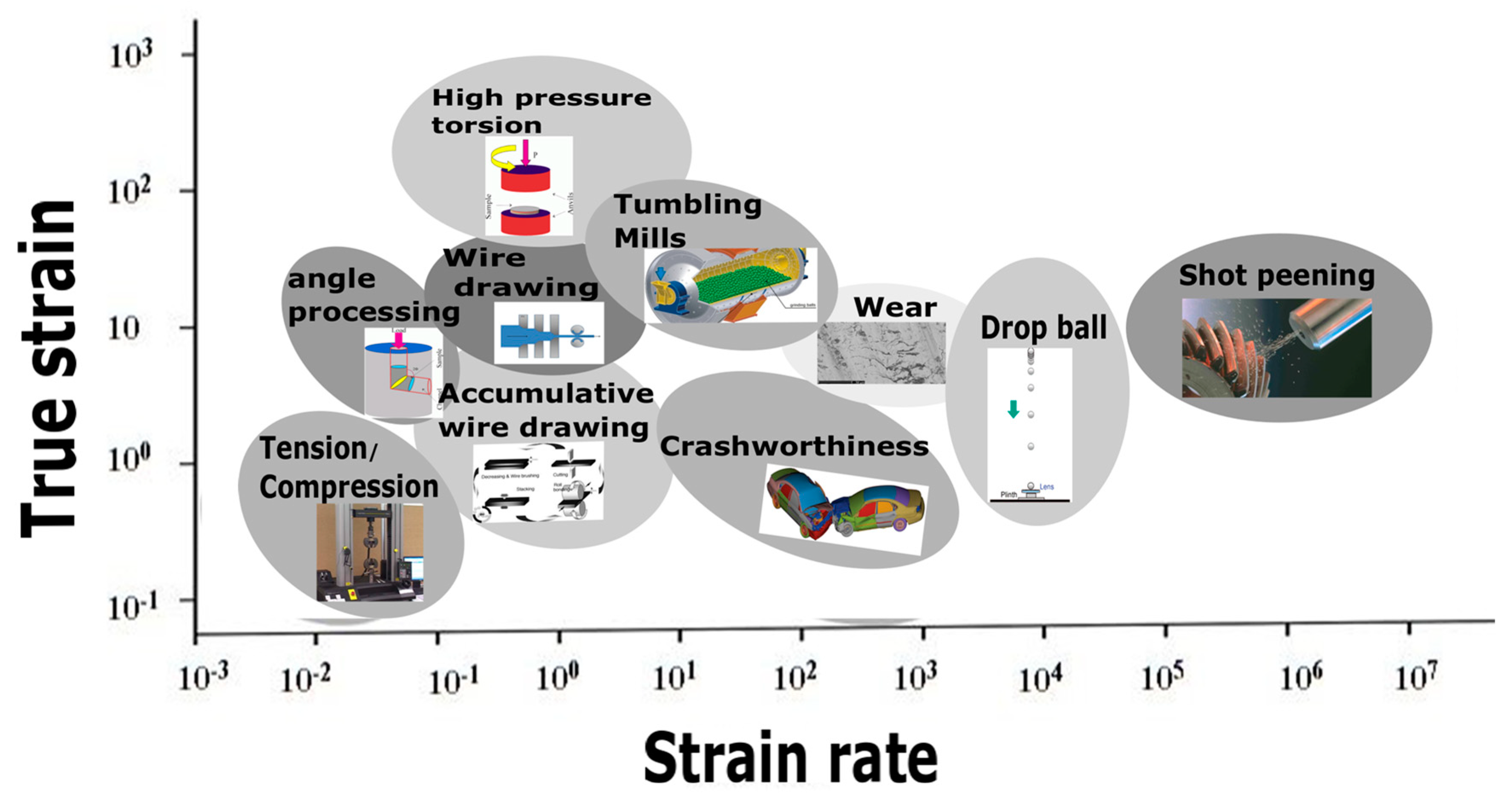
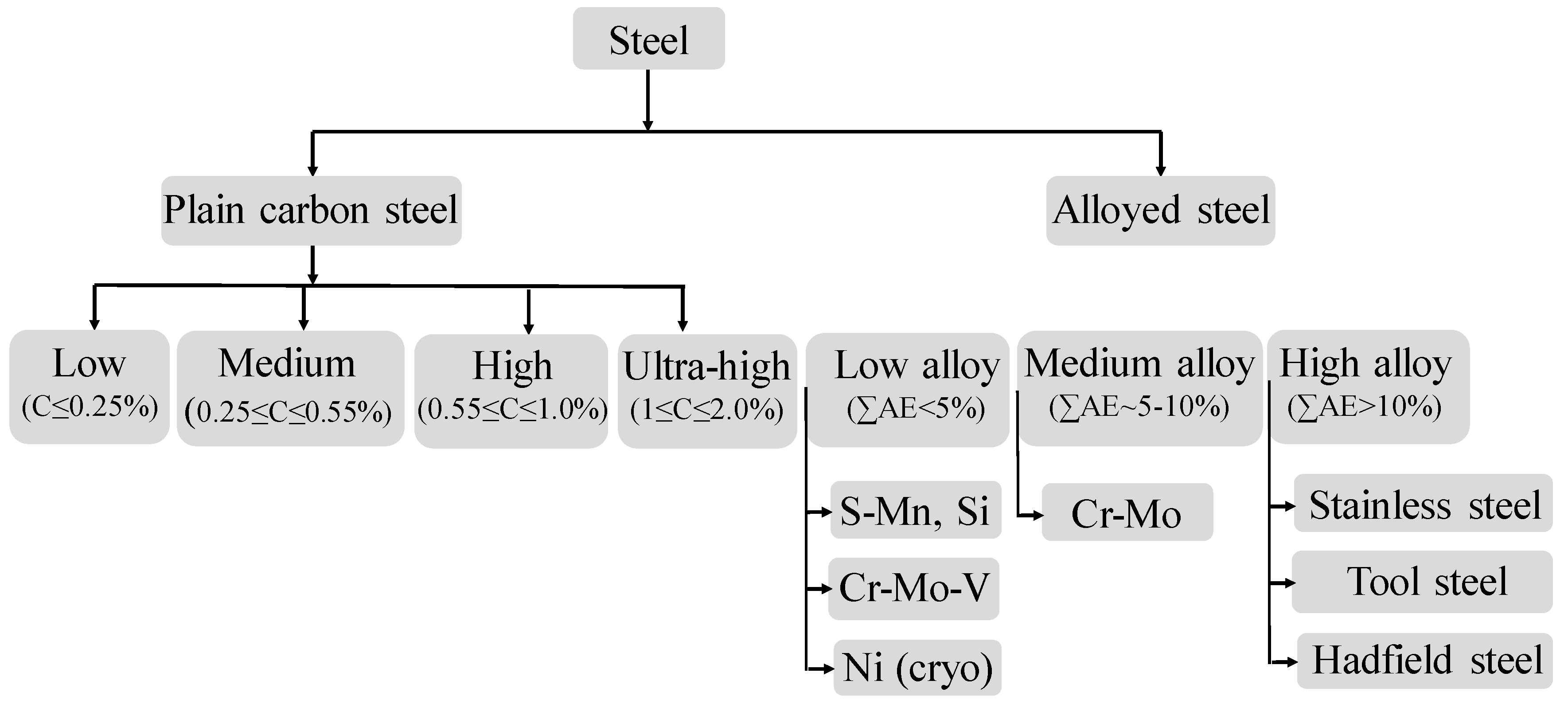
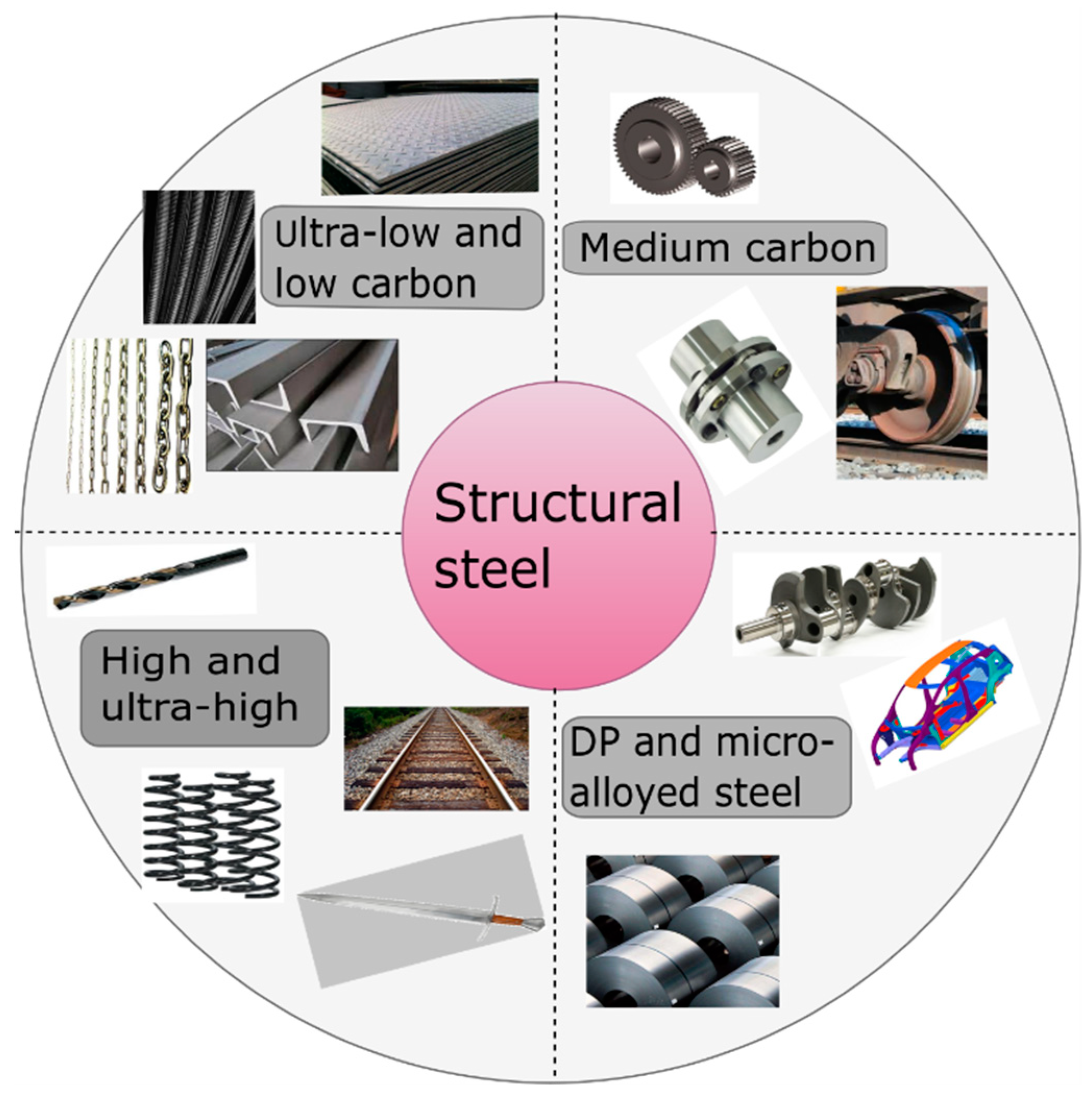
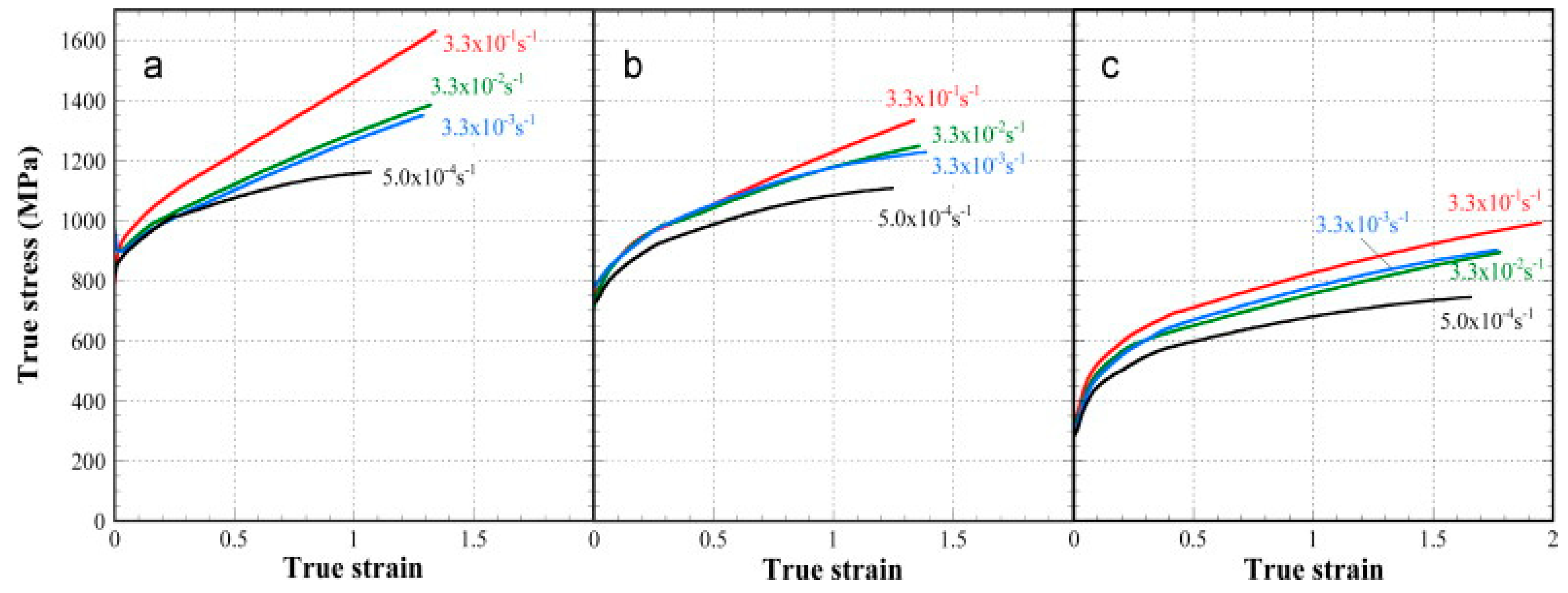
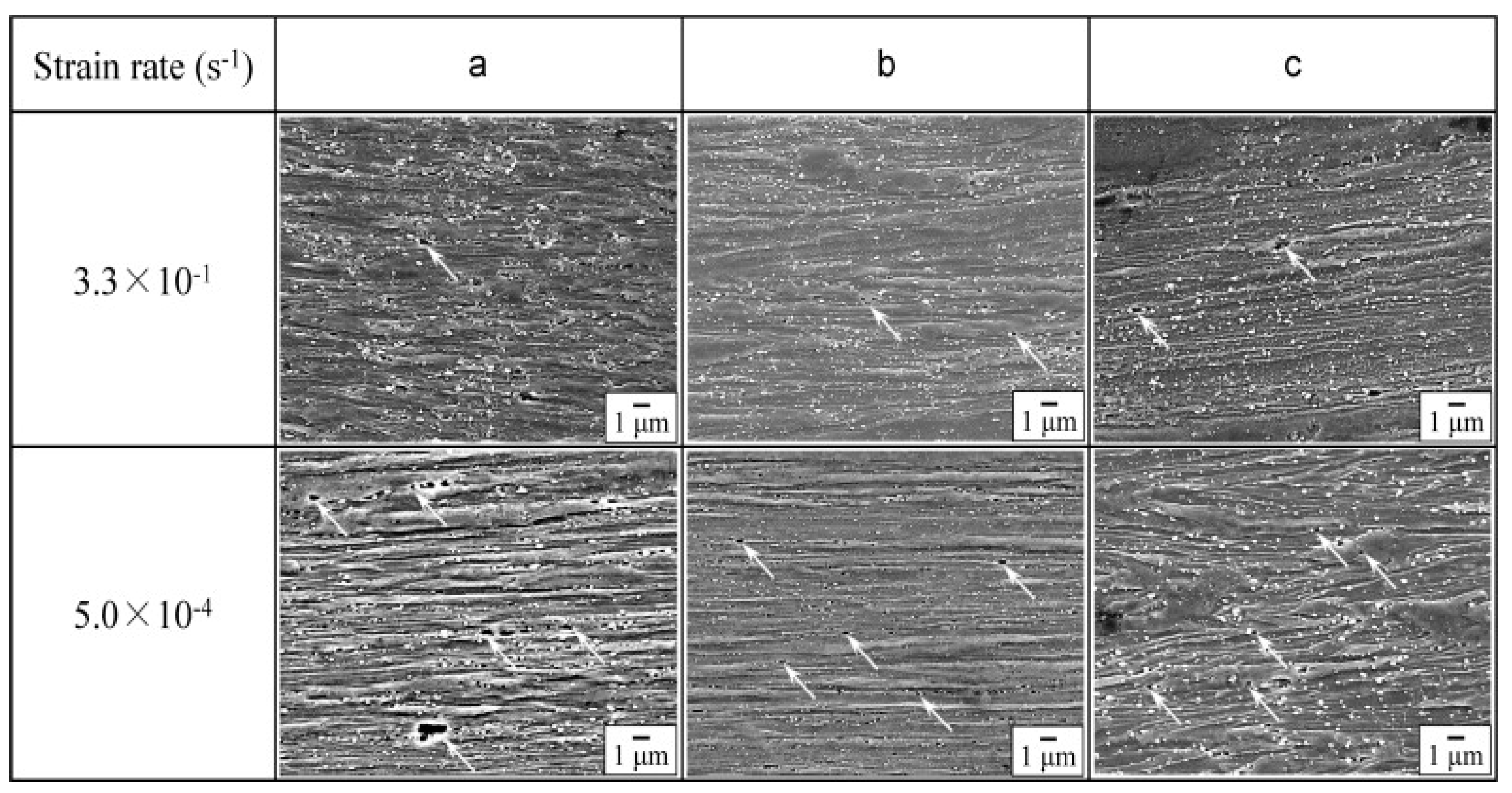
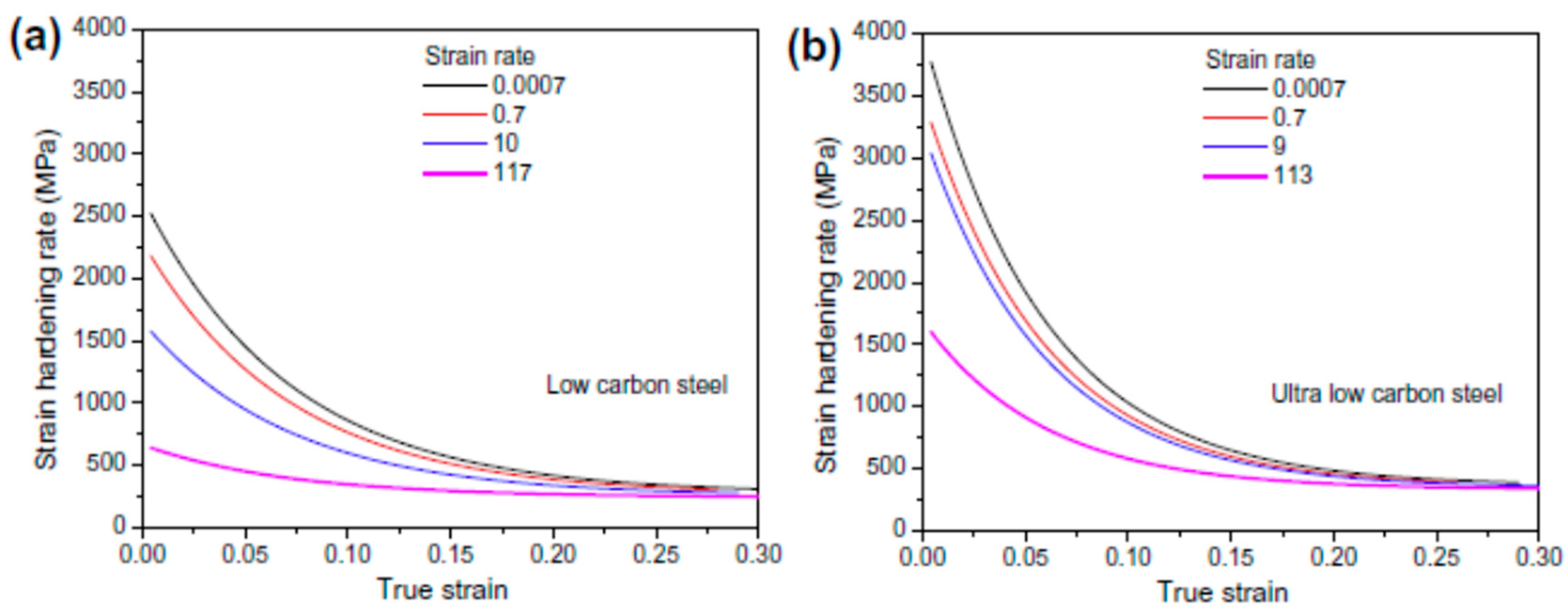

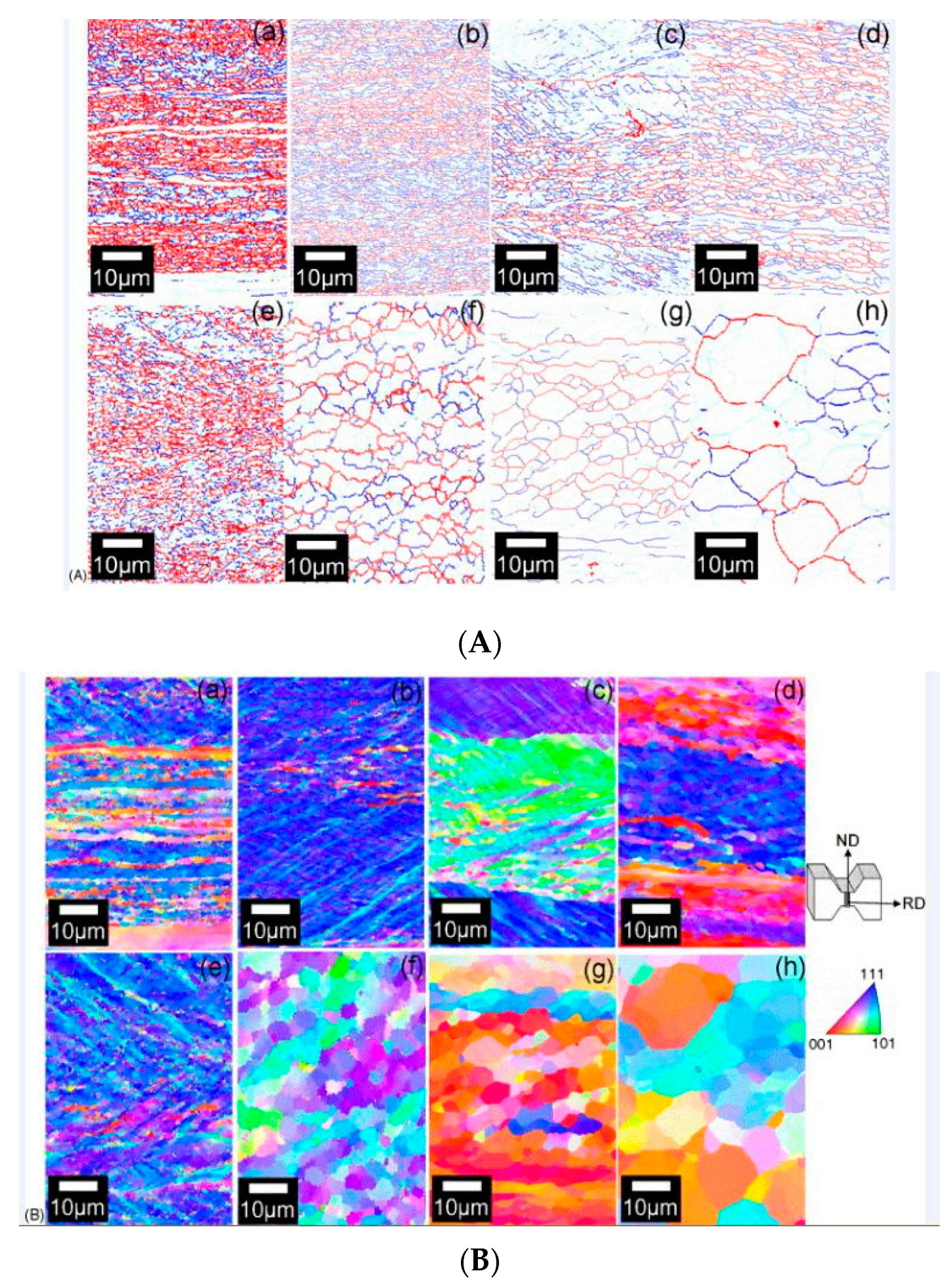
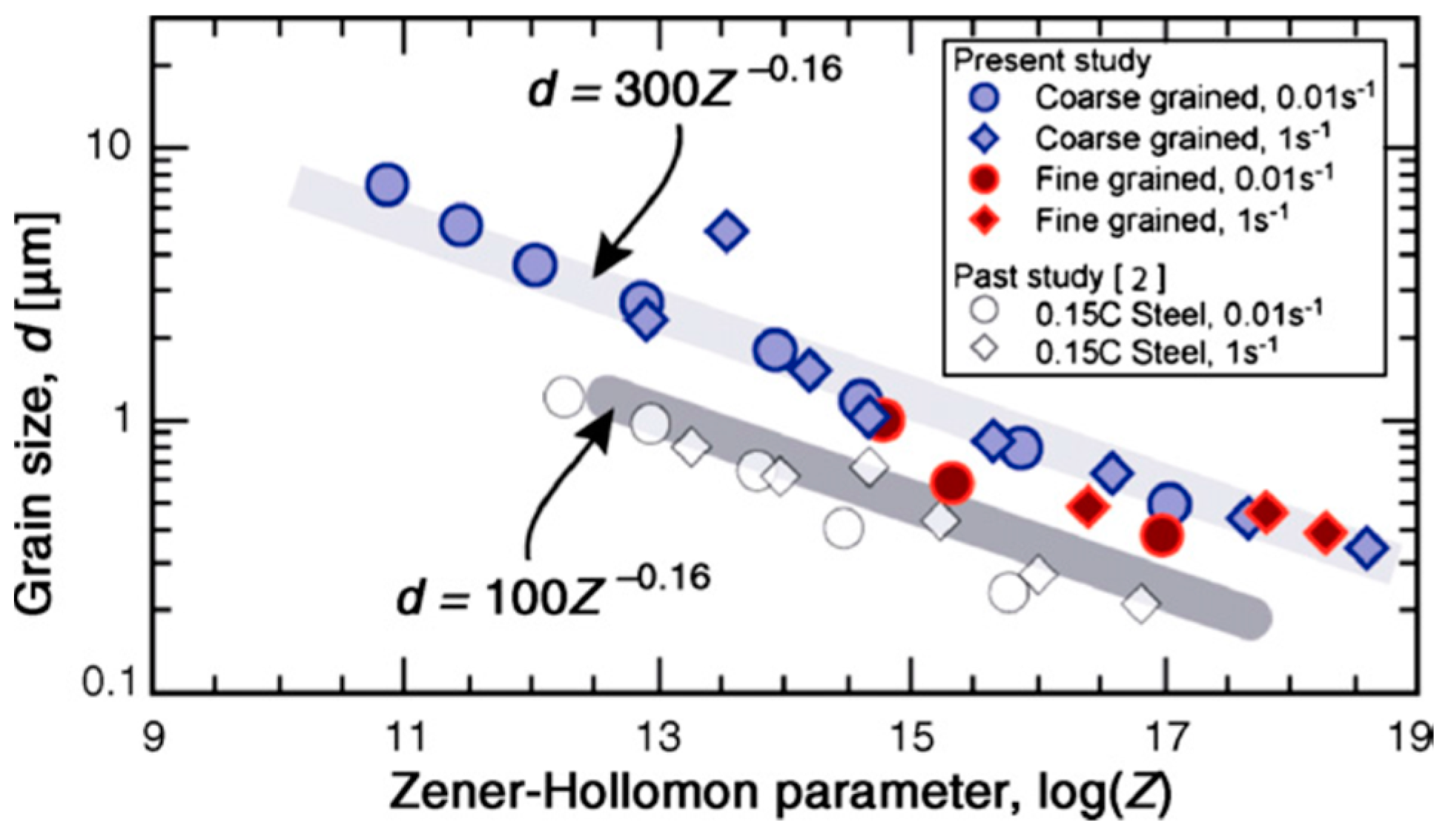
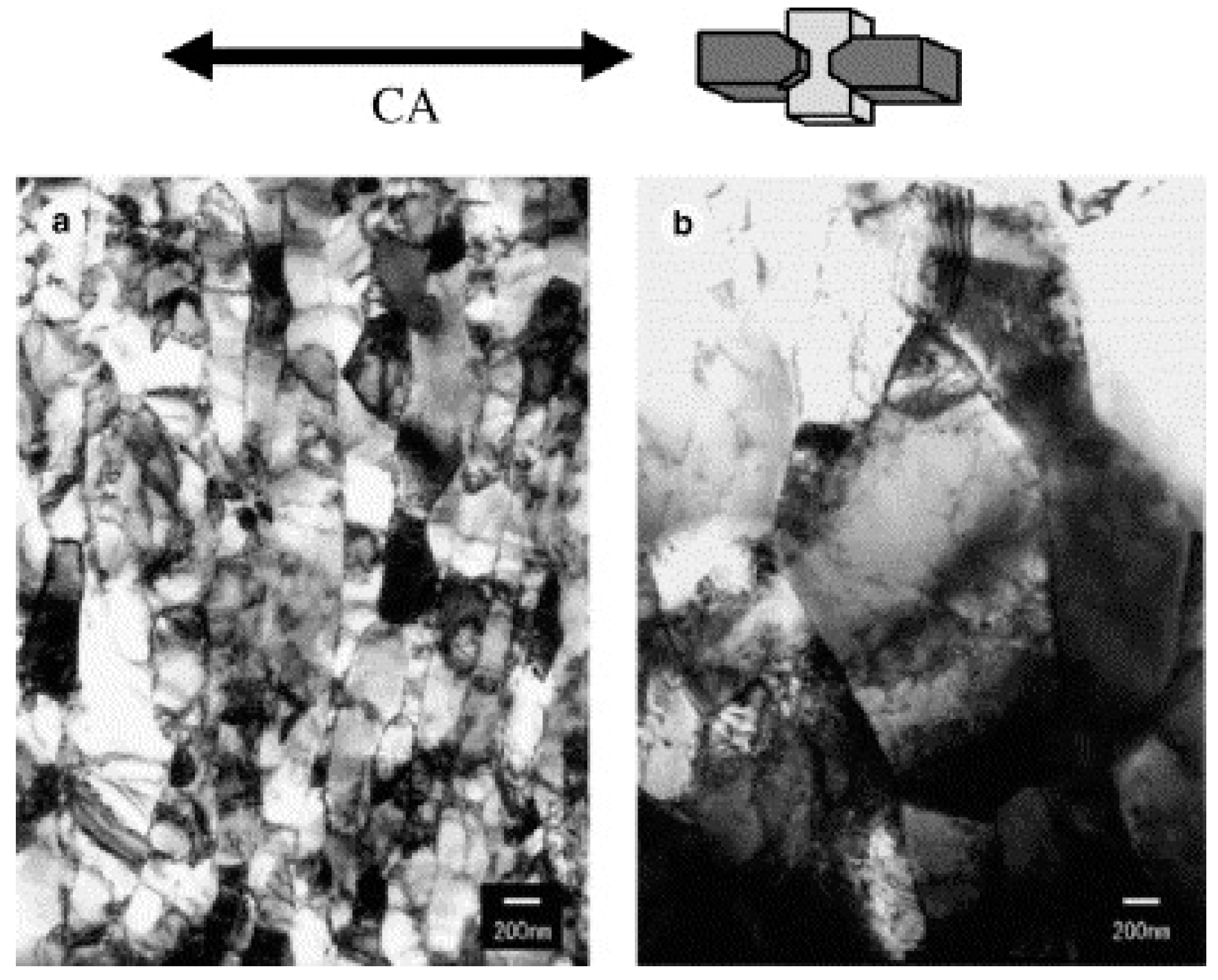


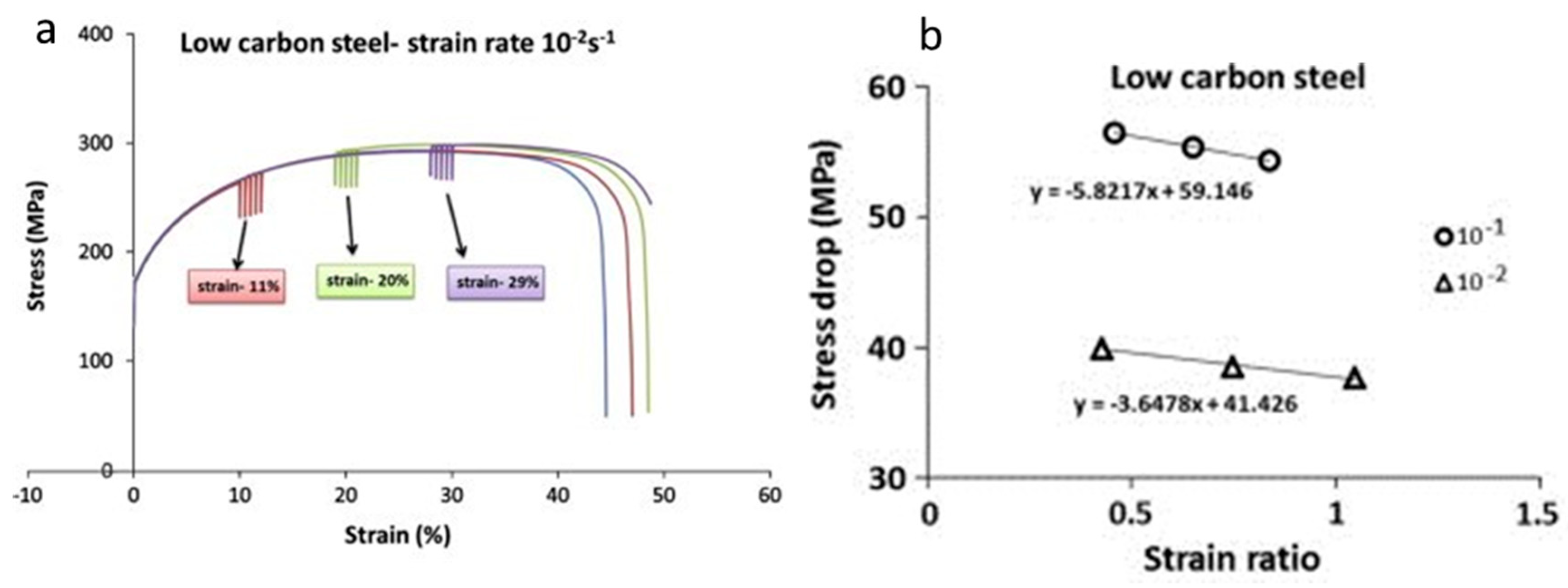
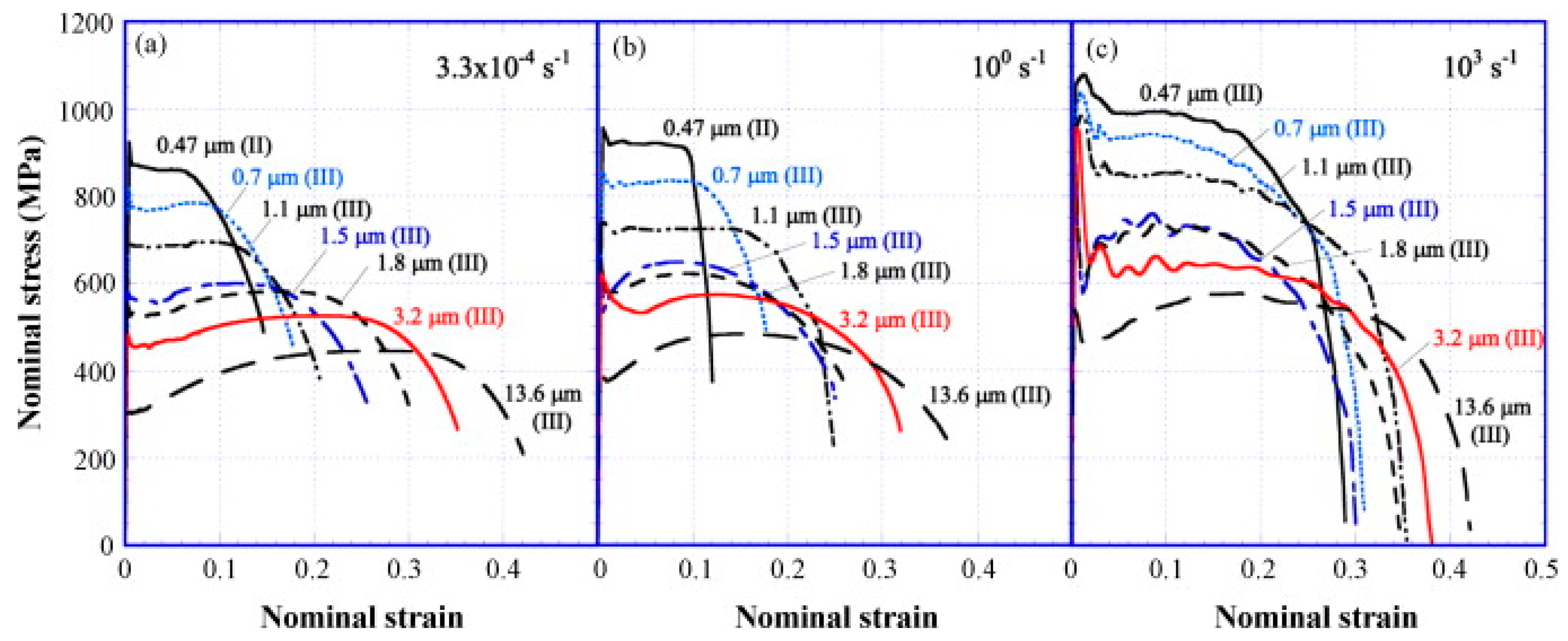

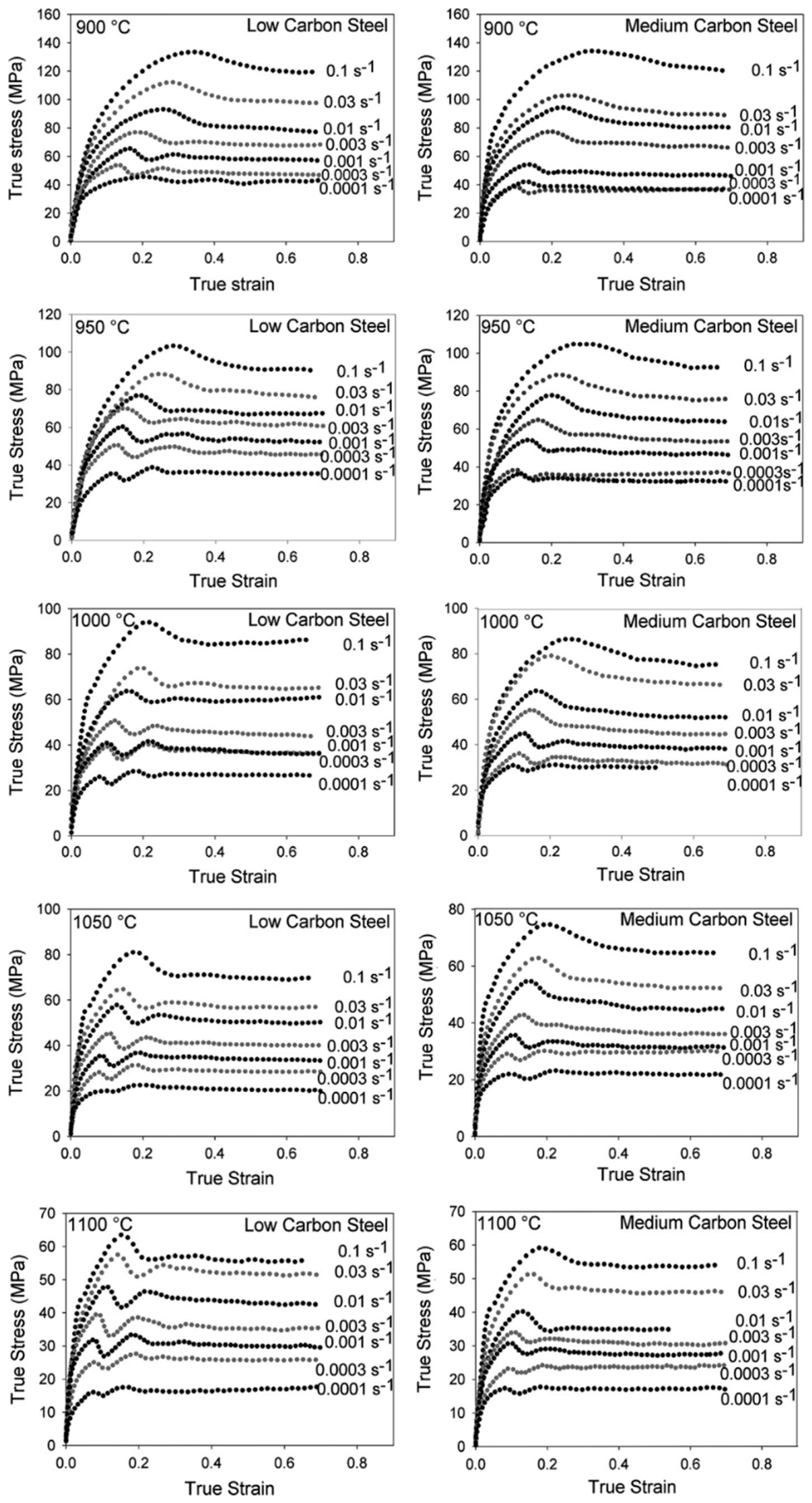
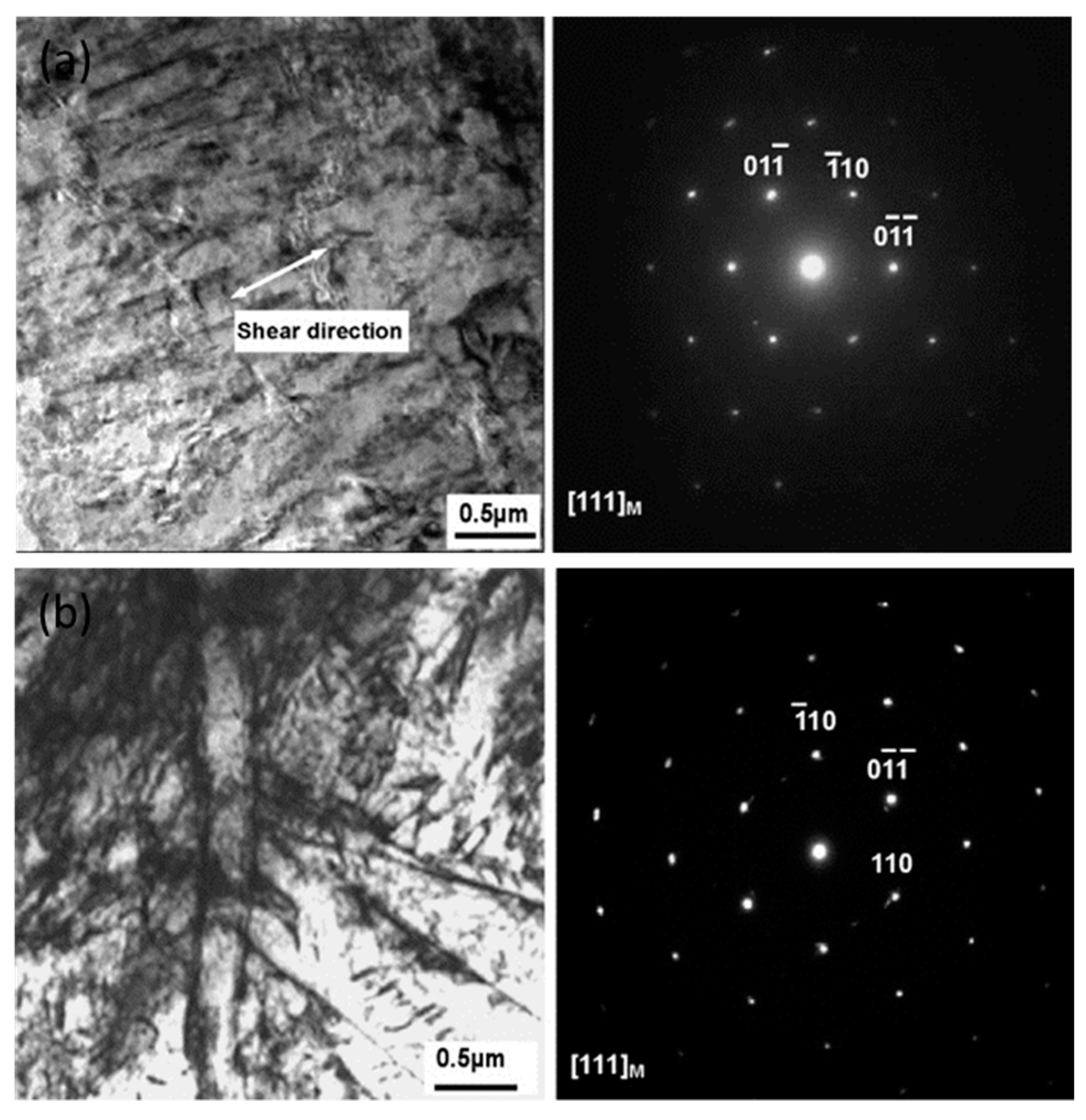

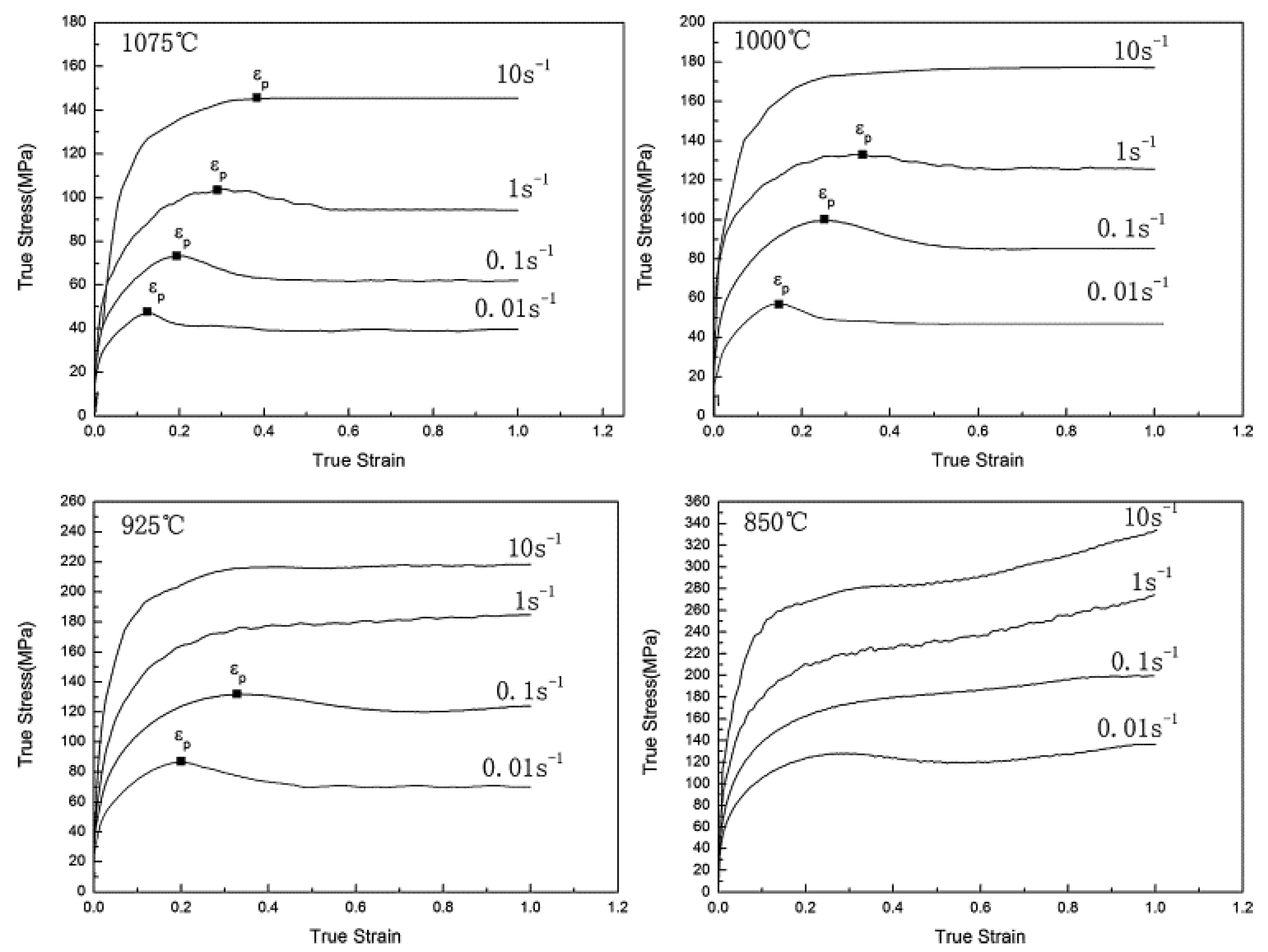

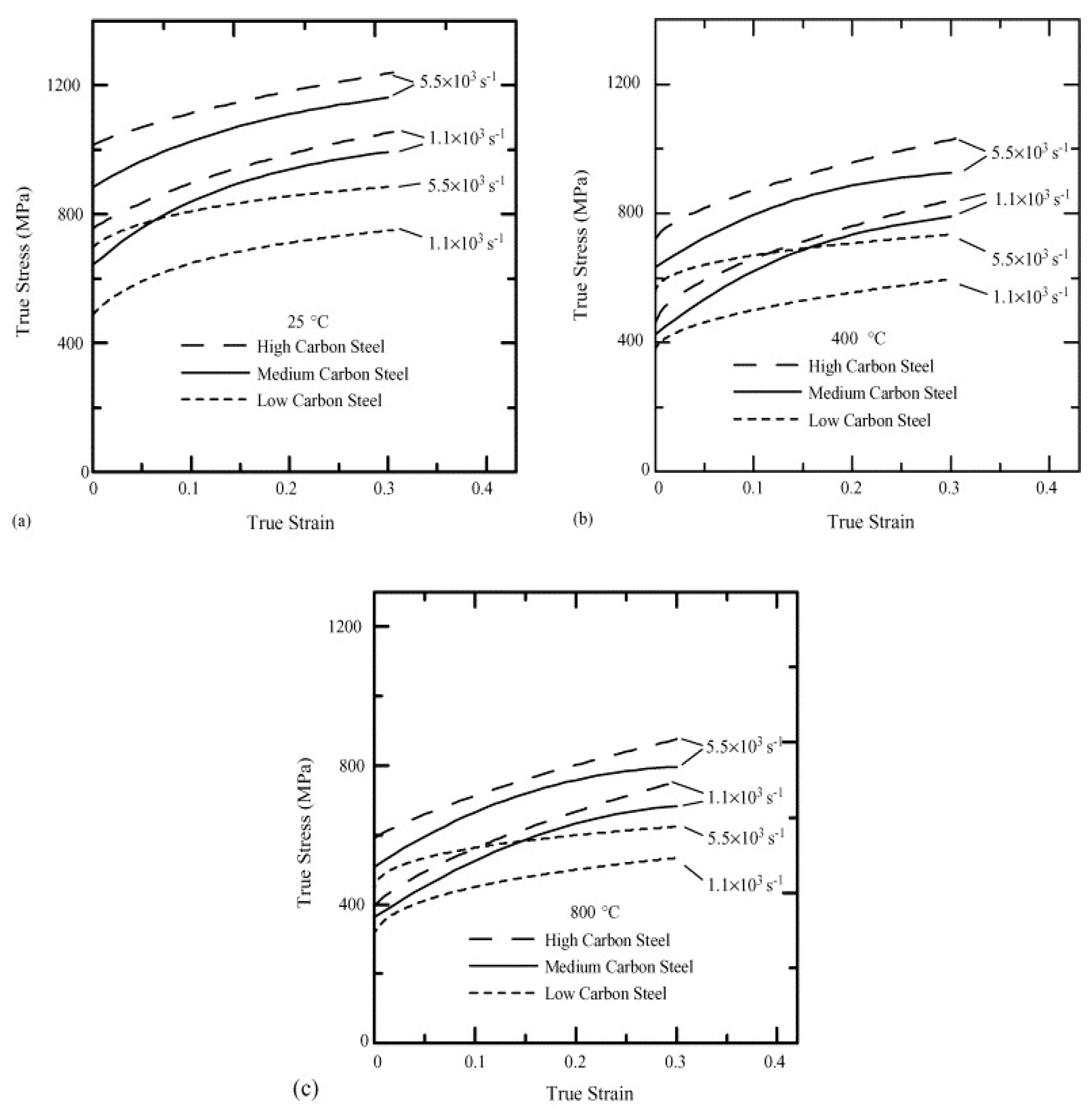
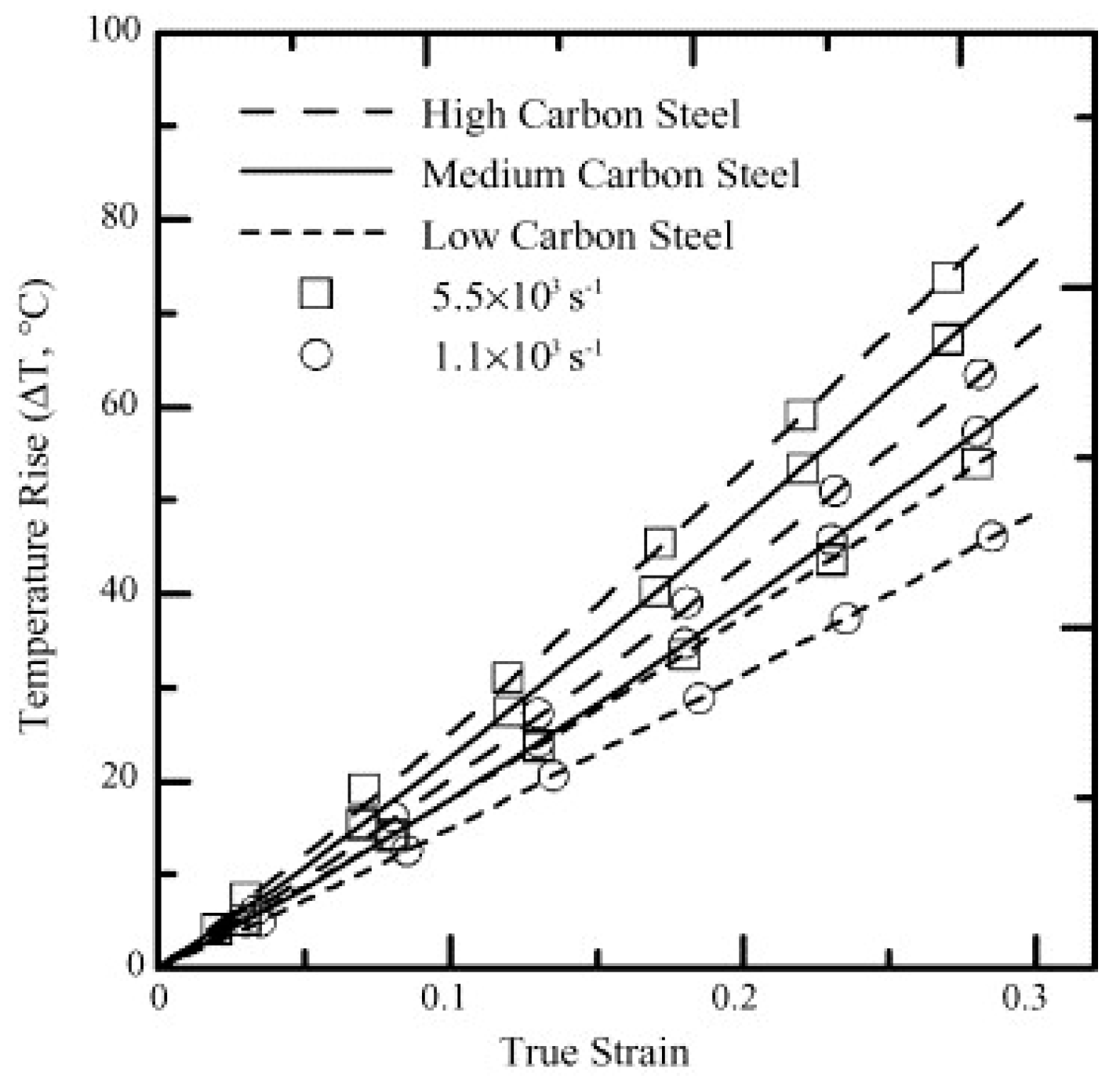
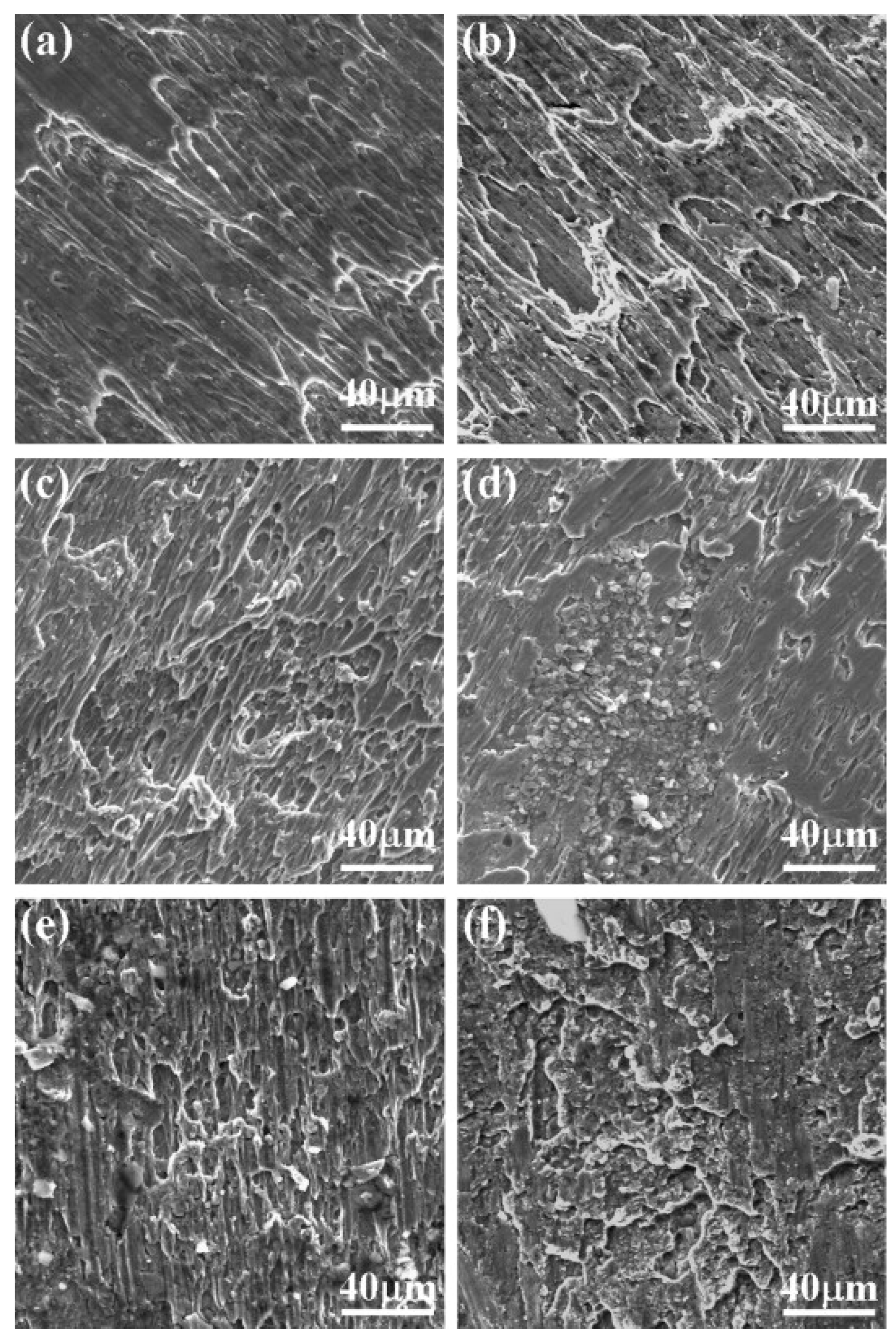
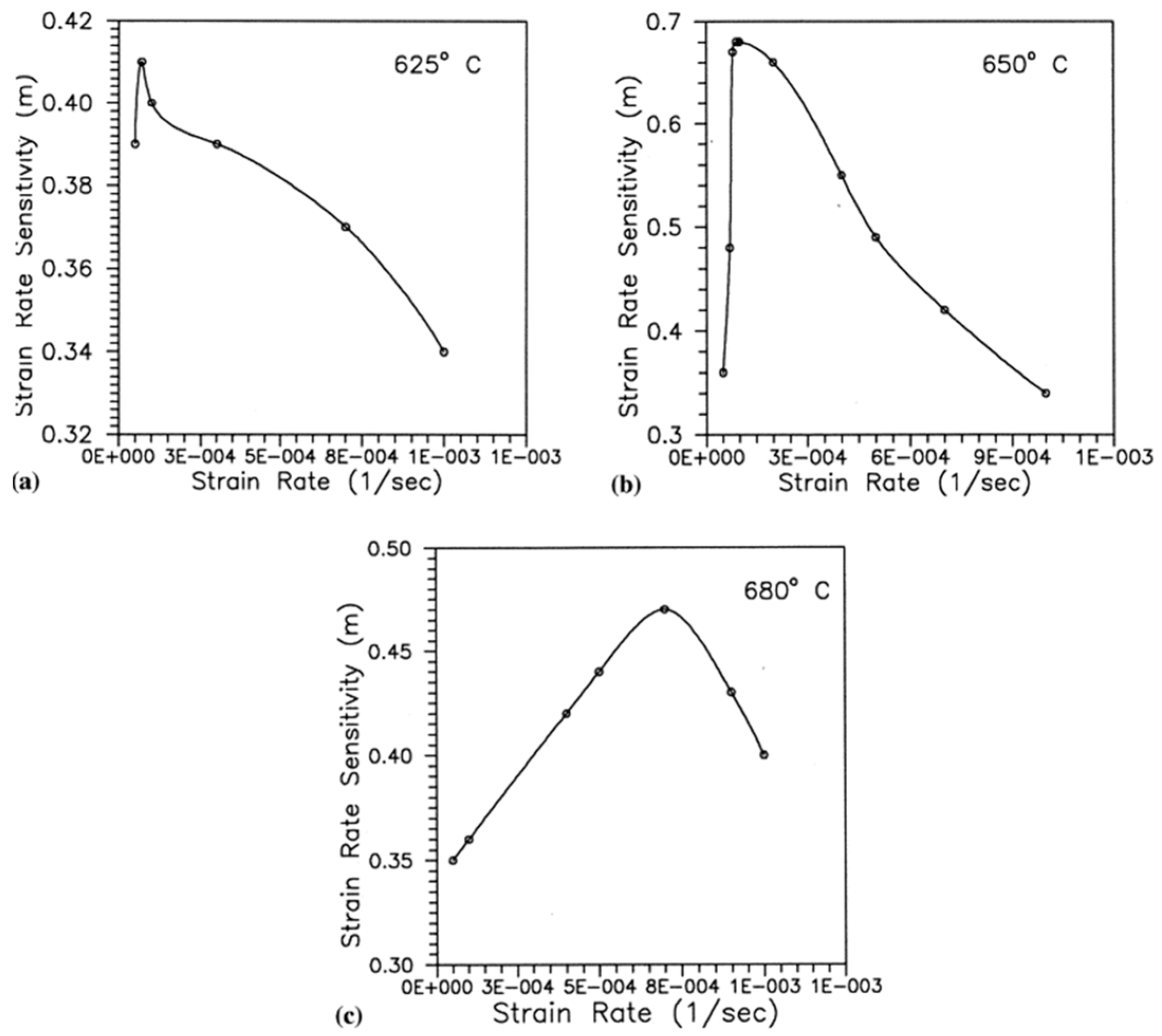
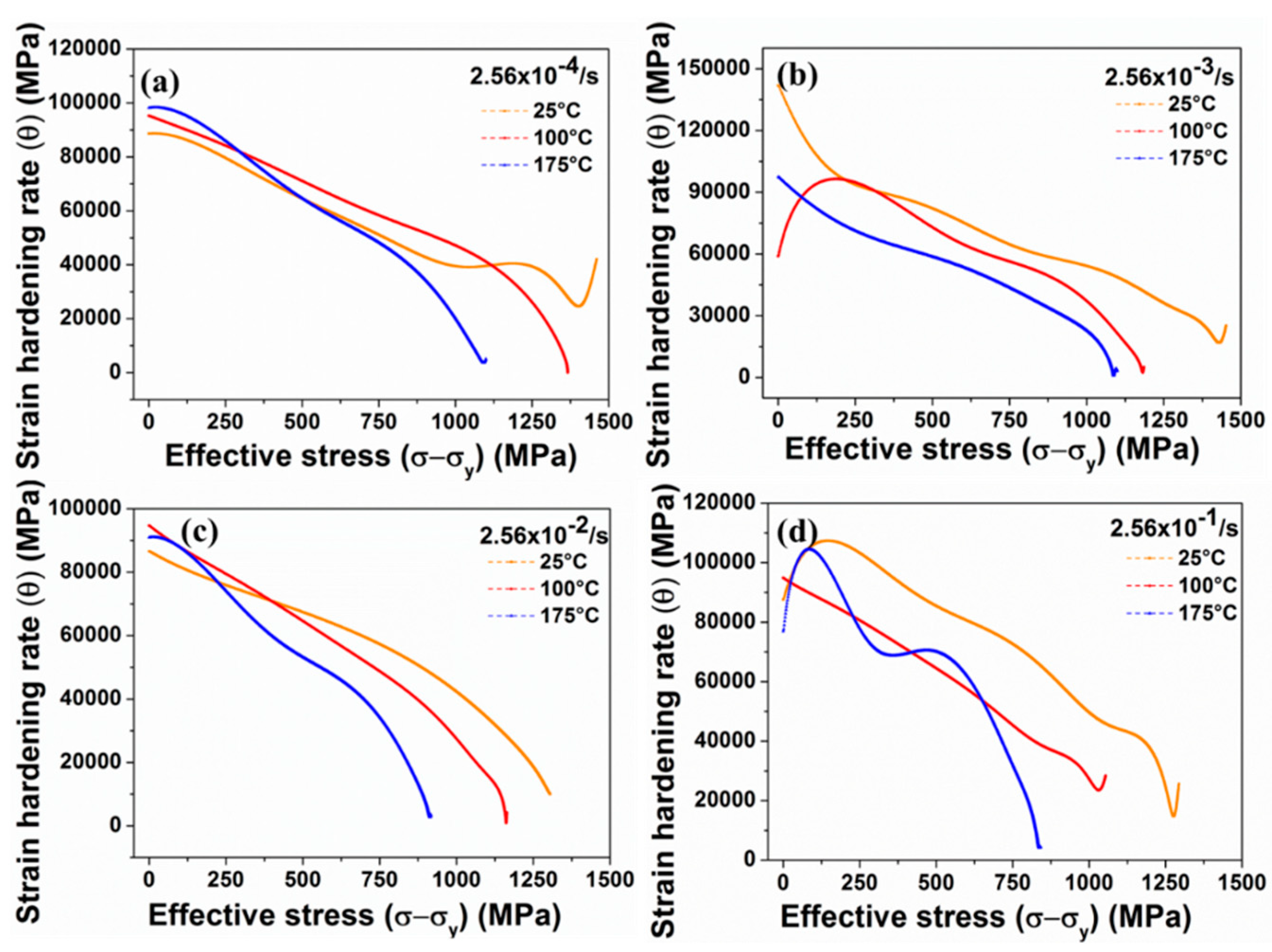
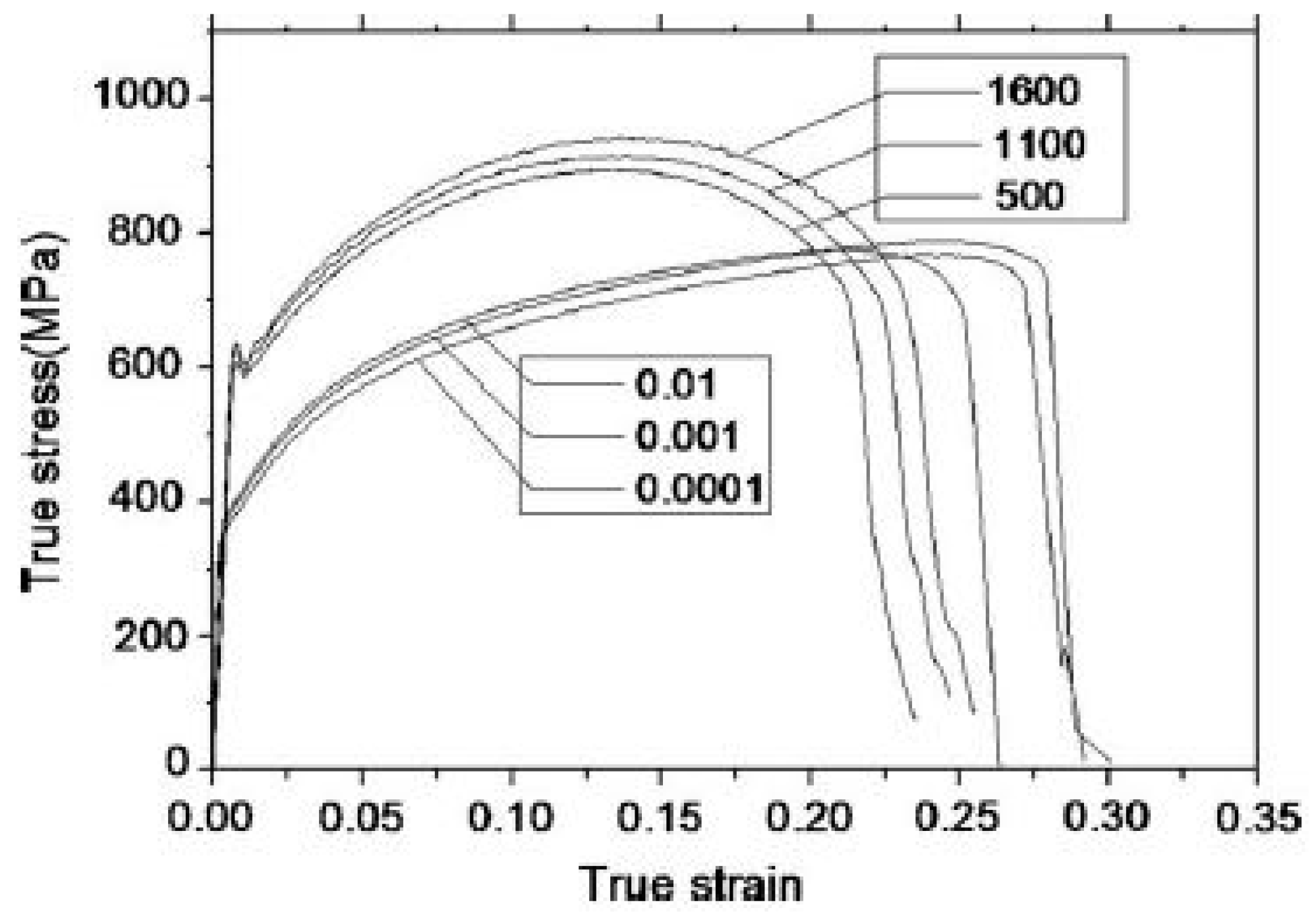


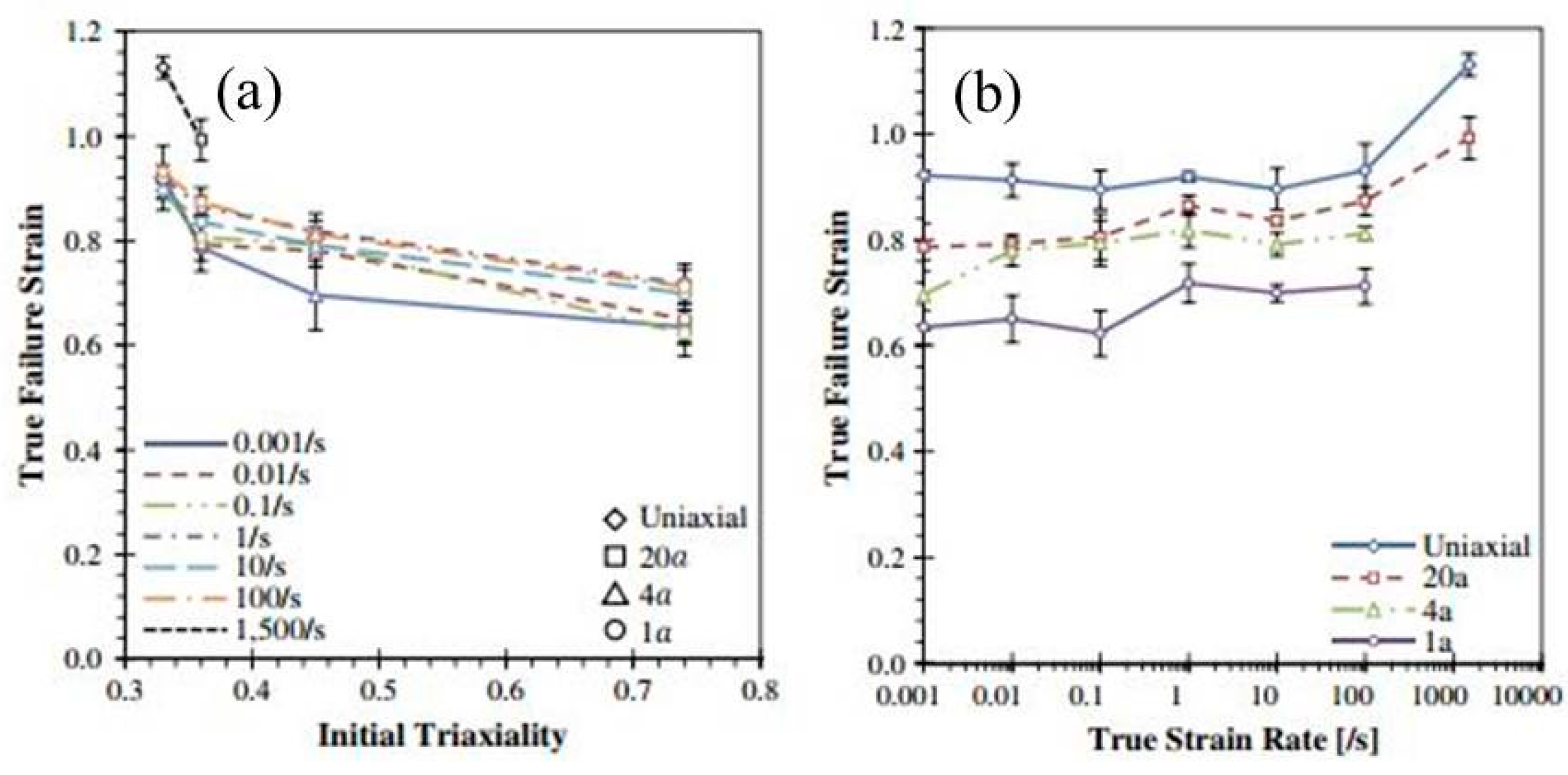
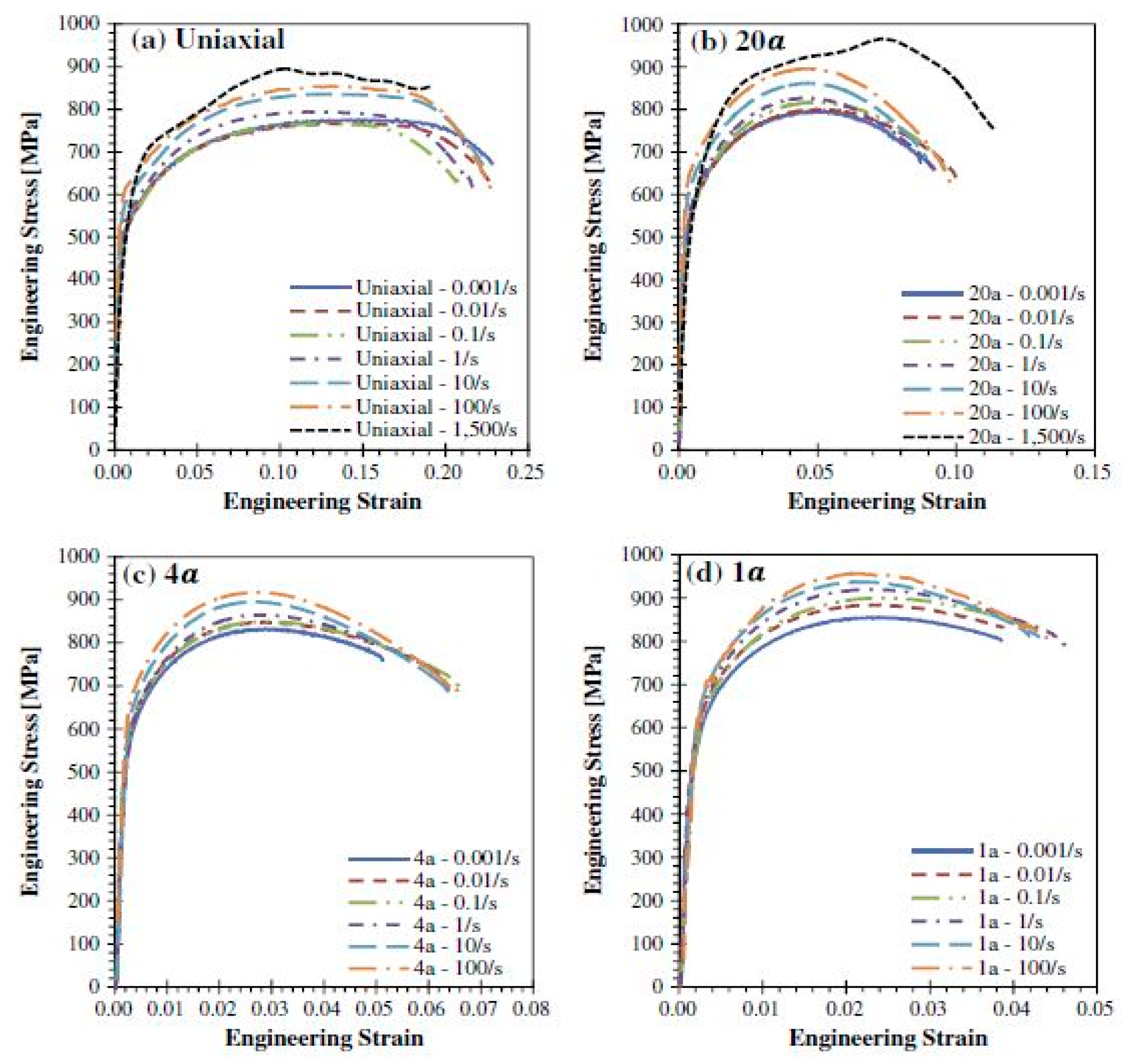

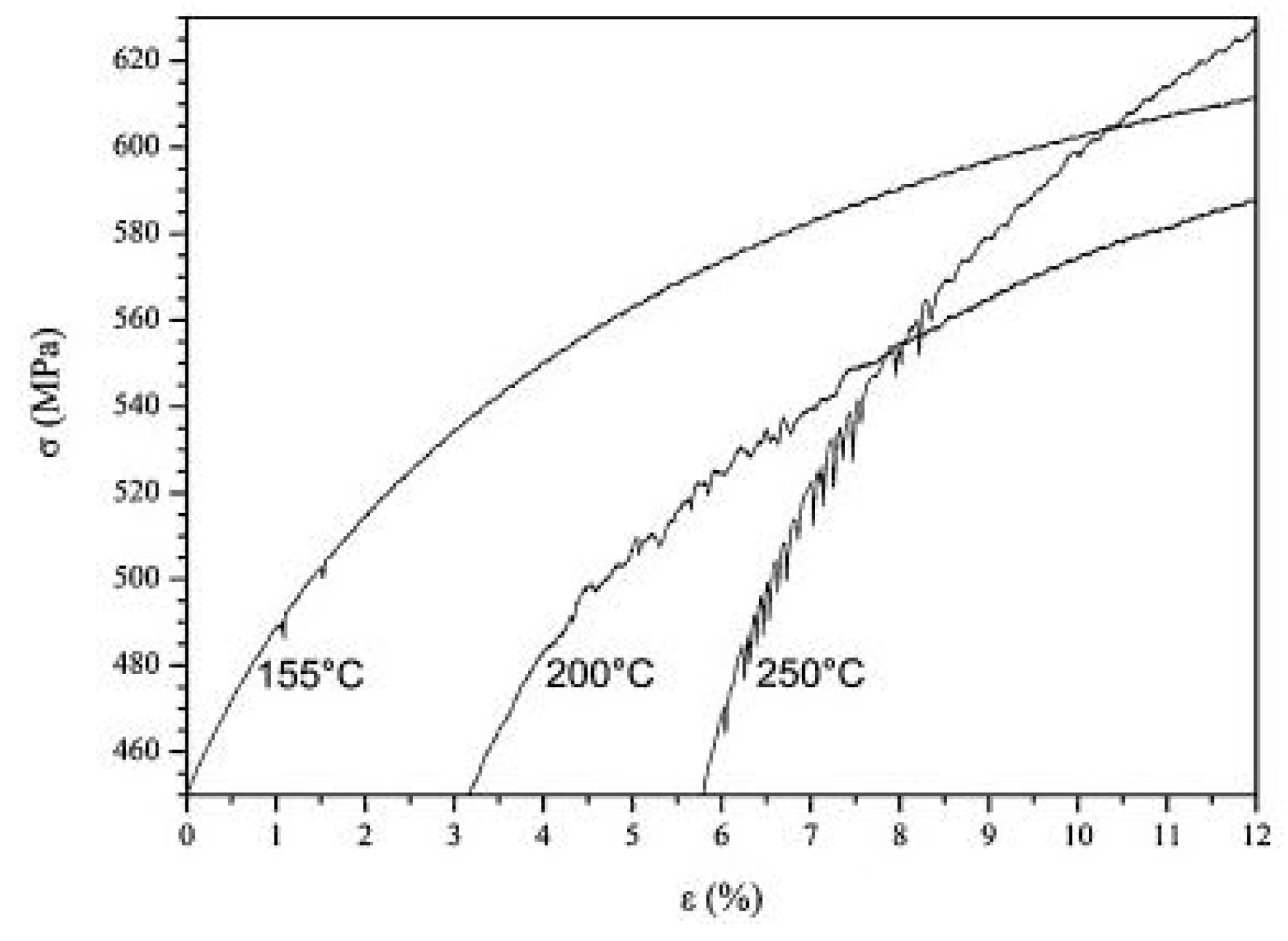
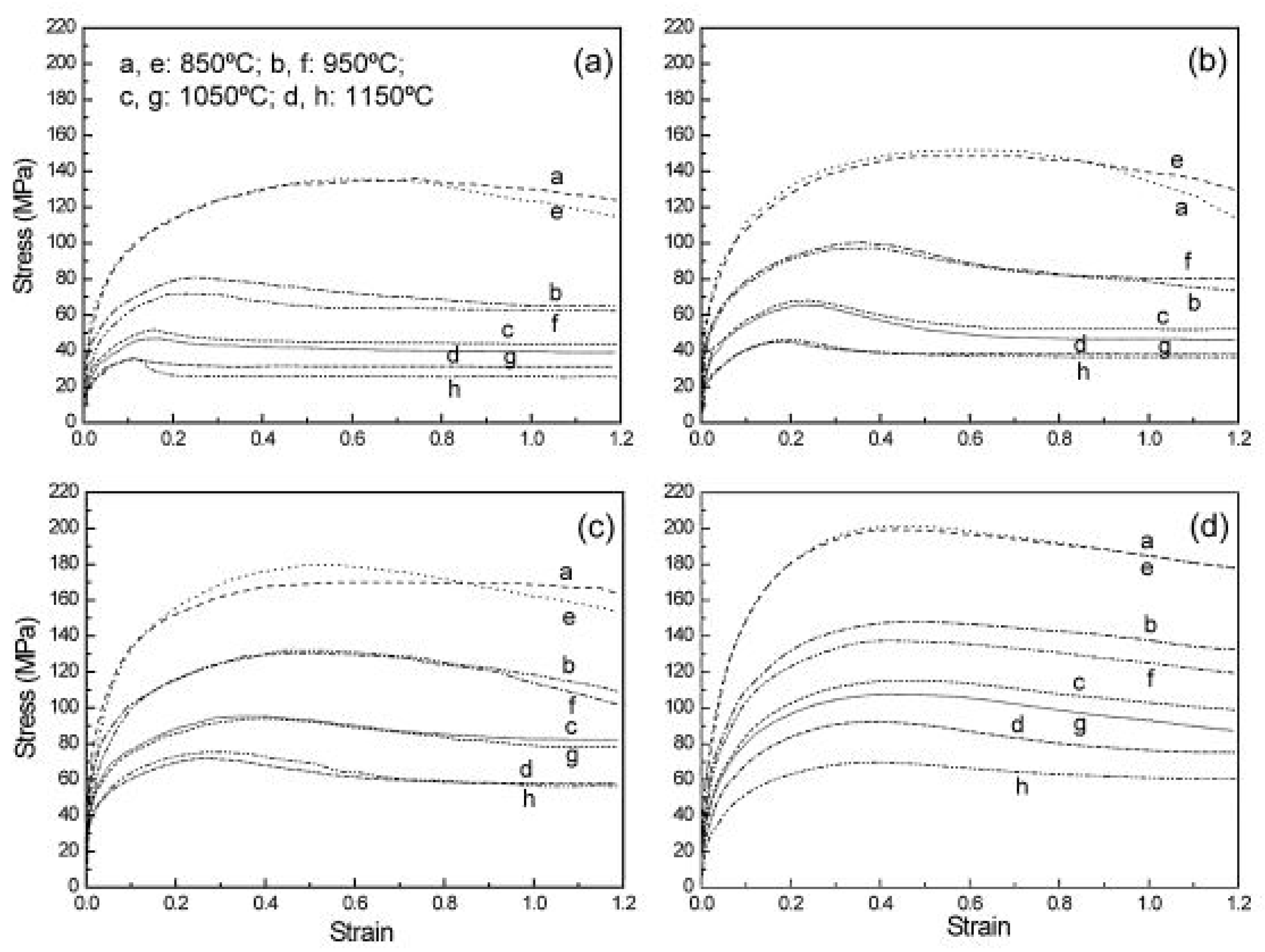
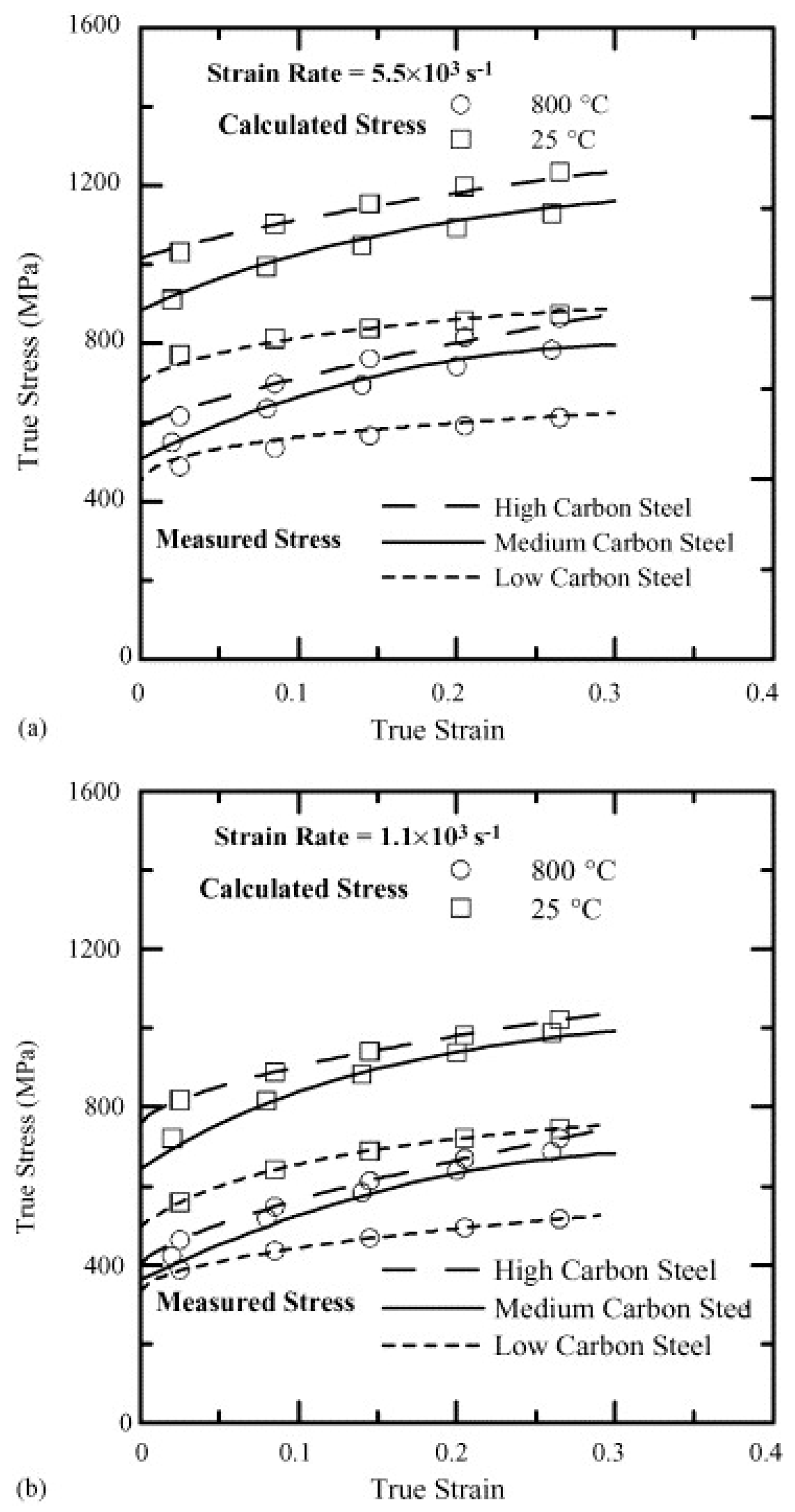
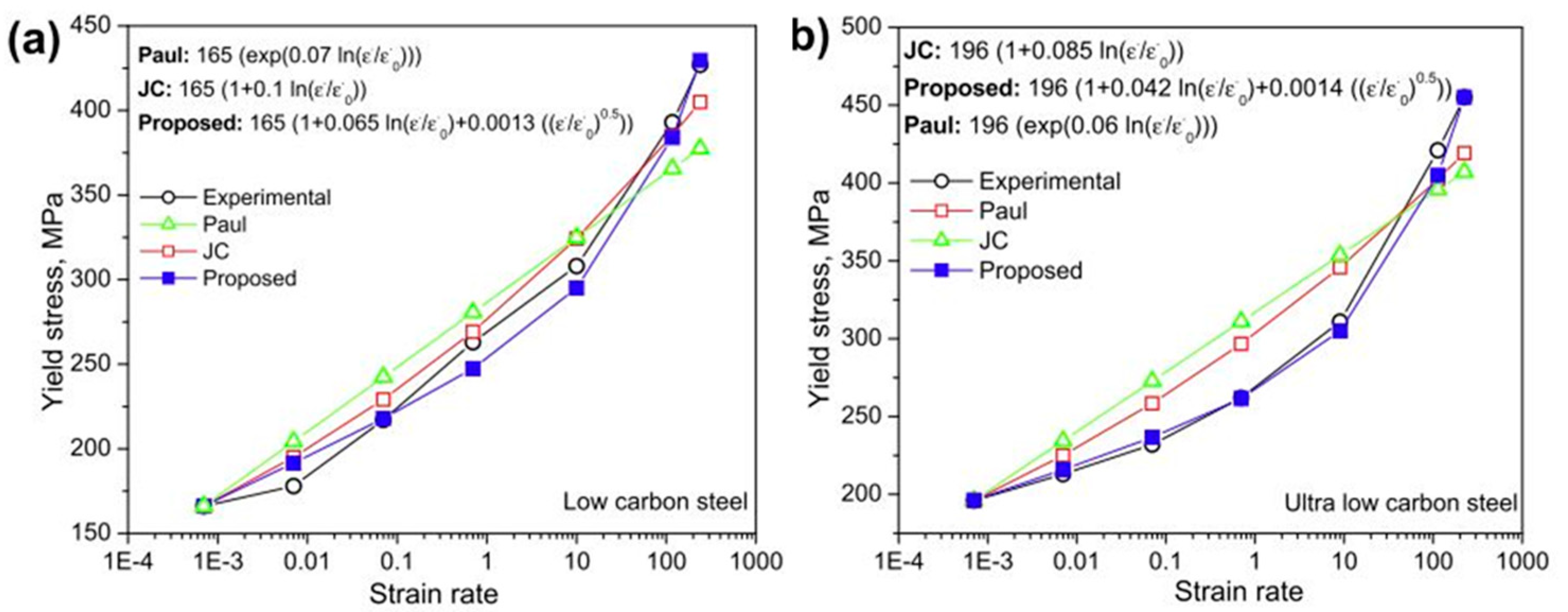
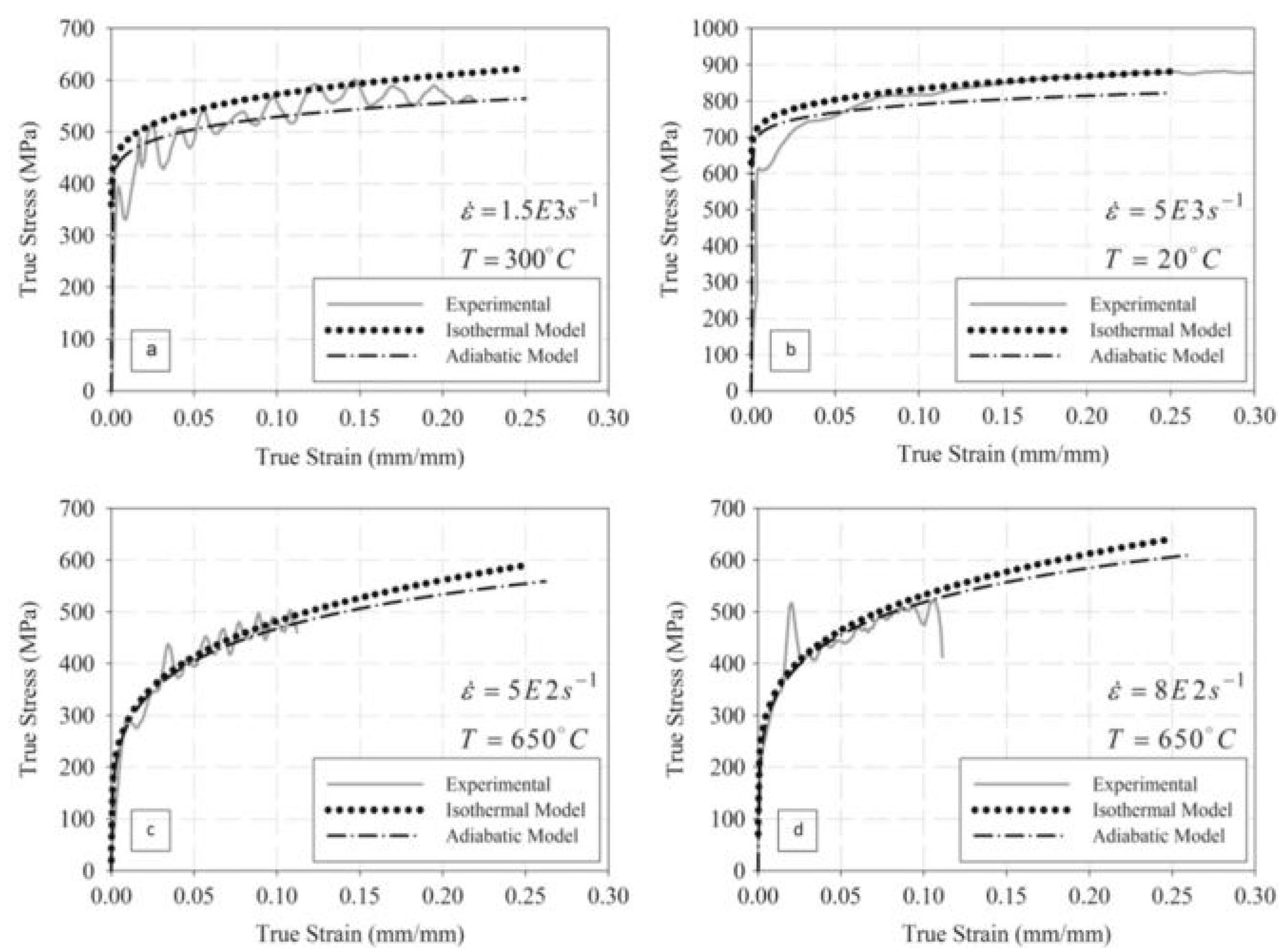
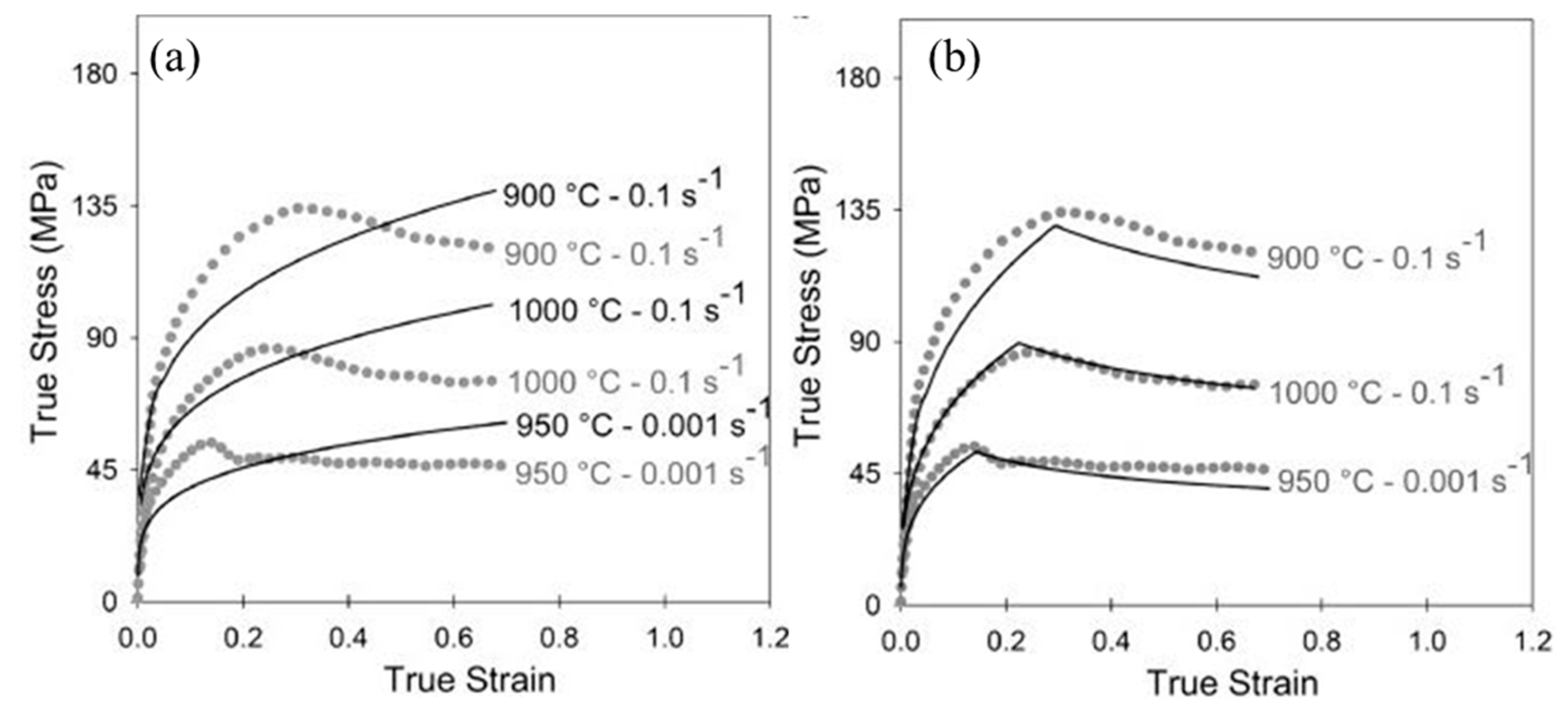
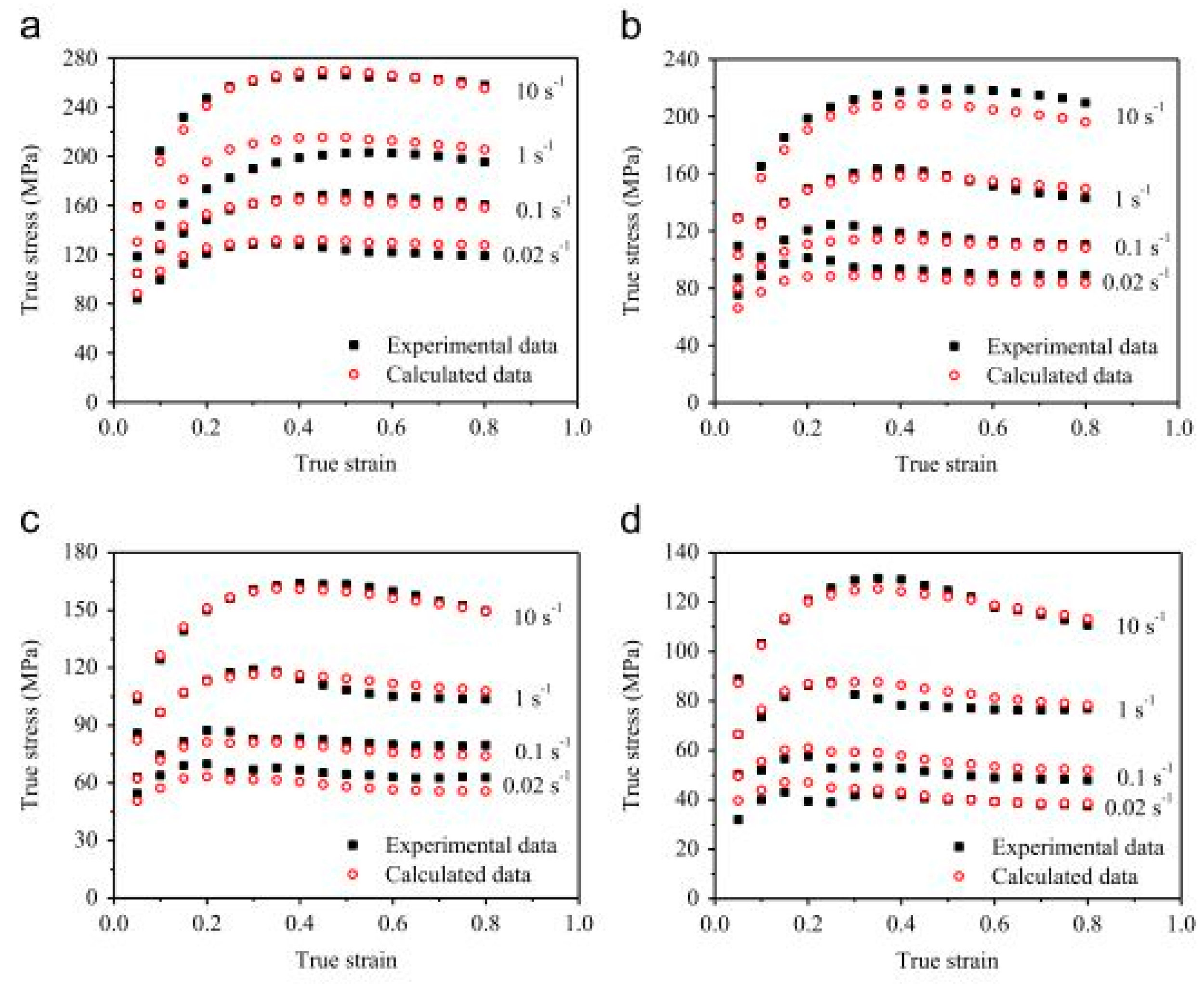
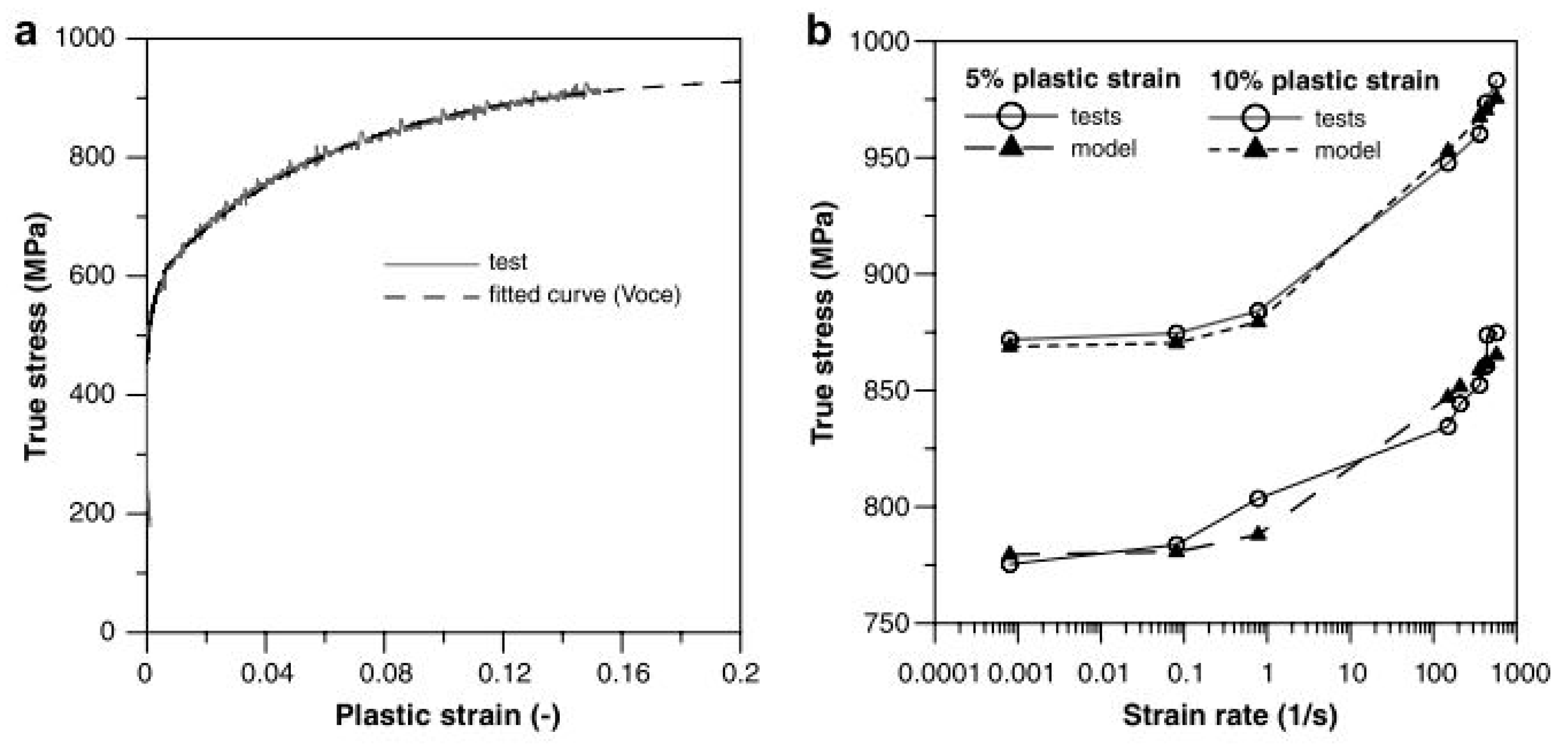
| Strain Rate (s−1) | Experimental Techniques |
|---|---|
| Compression Tests | |
| <0.1 | Conventional Load Frames, Gleeble |
| 0.1–100 | Special Servo-hydraulic Frames, Gleeble |
| 0.1–500 | Cam Plastometer and Drop Test |
| 200–104 | Split Hopkinson Pressure Bar (SHPB) |
| 103–105 | Taylor Impact Test |
| >105 | Single and two-stage gas gun |
| Tension Tests | |
| <0.1 | Conventional Load Frames, Gleeble |
| 0.1–100 | Special Servo hydraulic Frames, Gleeble |
| 100–103 | Split Hopkinson Pressure Bar (in tension) |
| 104 | Expanding Ring |
| >105 | Flyer Plate |
| Shear and Multiaxial Tests | |
| <0.1 | Conventional Shear Tests |
| 0.1–100 | Special Servo-hydraulic Frames |
| 10–103 | Torsional Impact |
| 100–104 | Split Hopkinson Pressure Bar (in torsion) |
| 103–104 | Double-notch Shear and Punch |
| 104–107 | Pressure-shear Plate Impact |
| Carbon Steel | Coefficients | |||||
|---|---|---|---|---|---|---|
| c1 (MPa) | c2 (MPa) | c3 (k−1) | c5 (k−1) | c5 (MPa) | n | |
| S15C | 315.75 | 615.38 | 0.013 | 0.0012 | 365 | 0.50 |
| S50C | 321.81 | 849.81 | 00997 | 0.000996 | 759.60 | 0.59 |
| SK93 | 460.04 | 700.11 | 0.00142 | 0.00152 | 712.02 | 0.69 |
| Steel | σo | B | C | β | A | K | G | H |
|---|---|---|---|---|---|---|---|---|
| Ultralow carbon | 190 | 360 | 215 | 17 | 0.042 | 0.0014 | 0.02 | 0.00045 |
| Low carbon | 165 | 270 | 170 | 14 | 0.065 | 0.0013 | 0.01 | 0.0009 |
| (MPa) | n | Kp (MPa/μm1/2) | Kf (MPa/μm1/2) | (MPa) | p | q | K (eV/K) | G0 (eV) | (S−1) |
|---|---|---|---|---|---|---|---|---|---|
| 346.5 | 0.2304 | 718.67 | 465 | 950 | 1 | 1.5 | 8.63 × 10−5 | 0.92 | 1.86 × 10−8 |
© 2020 by the authors. Licensee MDPI, Basel, Switzerland. This article is an open access article distributed under the terms and conditions of the Creative Commons Attribution (CC BY) license (http://creativecommons.org/licenses/by/4.0/).
Share and Cite
Prusty, B.G.; Banerjee, A. Structure–Property Correlation and Constitutive Description of Structural Steels during Hot Working and Strain Rate Deformation. Materials 2020, 13, 556. https://doi.org/10.3390/ma13030556
Prusty BG, Banerjee A. Structure–Property Correlation and Constitutive Description of Structural Steels during Hot Working and Strain Rate Deformation. Materials. 2020; 13(3):556. https://doi.org/10.3390/ma13030556
Chicago/Turabian StylePrusty, B. Gangadhara, and Amborish Banerjee. 2020. "Structure–Property Correlation and Constitutive Description of Structural Steels during Hot Working and Strain Rate Deformation" Materials 13, no. 3: 556. https://doi.org/10.3390/ma13030556
APA StylePrusty, B. G., & Banerjee, A. (2020). Structure–Property Correlation and Constitutive Description of Structural Steels during Hot Working and Strain Rate Deformation. Materials, 13(3), 556. https://doi.org/10.3390/ma13030556




